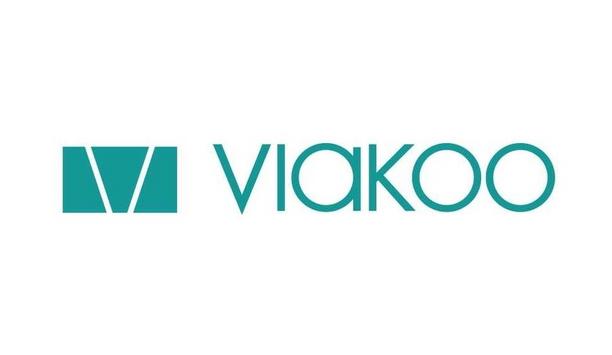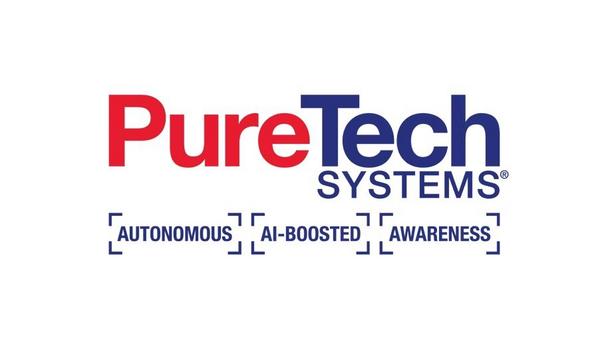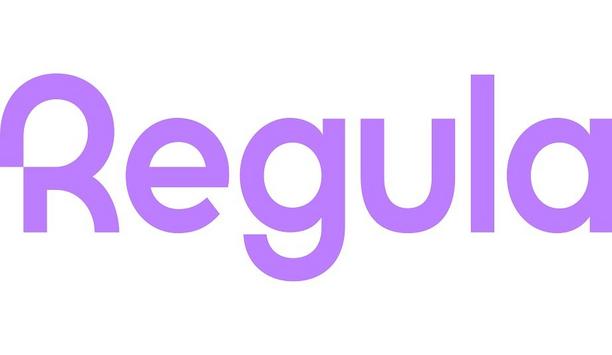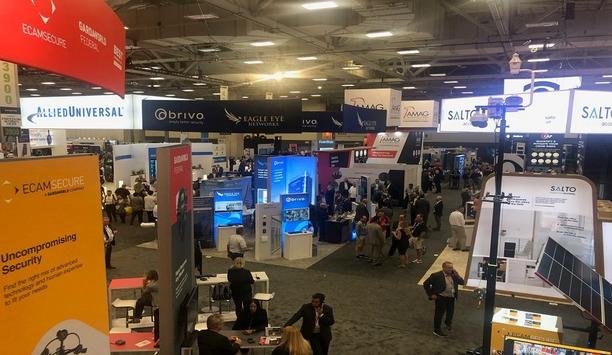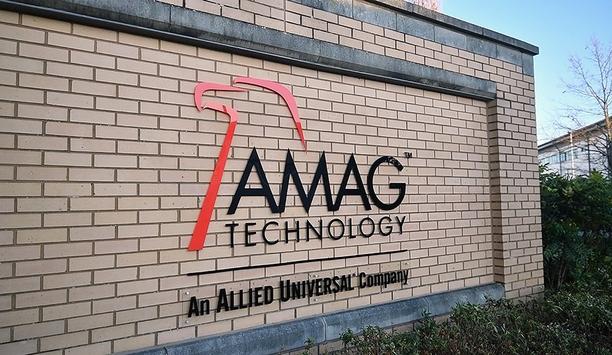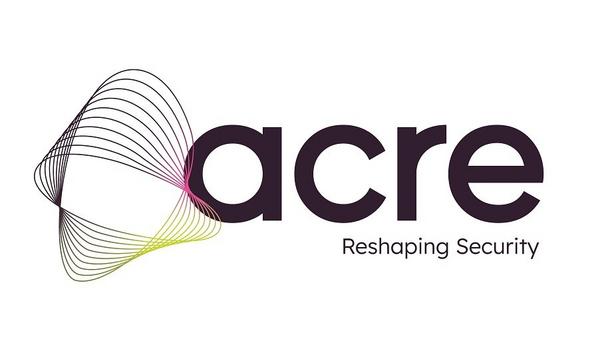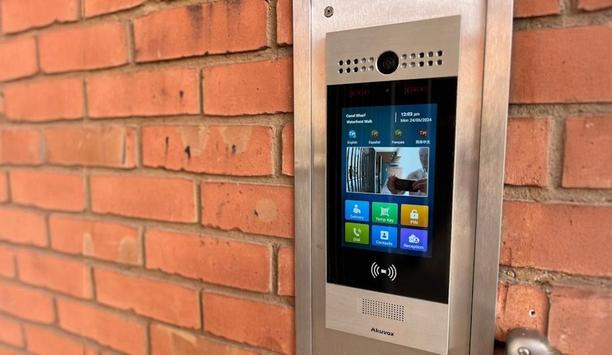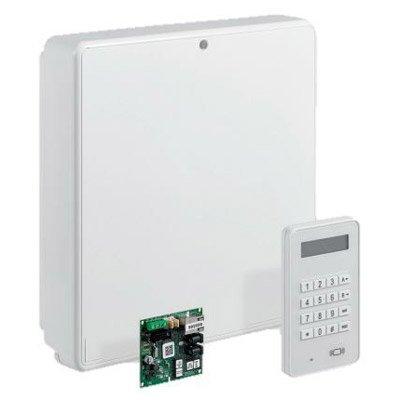Central Monitoring
Umazi, a pioneer in digital identity verification solutions, has welcomed the latest report from CFIT, Fighting Economic Crime Through Digital Verification: The Case for Adopting a Digital Company ID in the UK. The report highlights the potential to revolutionise business operations in the UK by improving efficiency, security, and trust. Innovating business verification CFIT has convened over 70 pioneer organisations to design and develop the Digital Company ID—a unique digital represen...
Smiths Detection, a global pioneer in threat detection and security screening and a business of Smiths Group, has announced a new partnership with NeuralGuard to advance AI-driven threat detection in security screening. NeuralGuard’s AI technology is undergoing integration and certification for use with Smiths Detection’s HI SCAN 6040 2-is. This collaboration was undertaken as part of Smiths Detection’s Ada Initiative, the company’s structured framework for accelerating...
ImmuniWeb Community Edition is a set of free online security tests that have performed over 380 million of successful security tests and scans since 2019. Publicly accessible data from the Community Edition is also utilised in the upcoming 2025 Data Breach Investigations Report by Verizon. In 2025, each day over 100,000 scans are run, testing web, mobile and cloud security, as well as detect phishing campaigns and data leaks on the Dark Web. Cyber threat exposure ImmuniWeb offers a foundation...
Viakoo, a pioneer in Cyber-Physical Systems and Internet of Things vulnerability remediation, announced significant platform enhancements, strategic partnerships, and a clear path forward to address the escalating challenge of AI-driven cyber threats to the physical security industry. The company made the announcement at ISC West 2025, underscoring its commitment to a proactive, collaborative approach. In a related move, Viakoo has also issued an Open Letter to the Physical Security community,...
SYSGO, a European pioneer in secure real-time software solutions, has been chosen to supply cutting-edge software technology for the EAGLE-1 project. This innovative mission, led by SES, a provider of global content and connectivity solutions, in collaboration with 20 European partners and supported by the European Space Agency and the European Commission, will enable long-distance Quantum Key Distribution. The mission's goal is to design, launch, and operate EAGLE-1, establishing the first so...
PureTech Systems Inc., a pioneer in geospatial AI-boosted video analytics for wide-area perimeter and border security, is proud to announce the integration of its patented, award-winning SaaS solution, PurifAI™, with IMMIX’s CS & GS video monitoring platforms. This integration delivers a breakthrough in video alarm validation, significantly reducing nuisance alarms while enhancing the efficiency of both self-monitoring and central monitoring operations. PureTech’s ad...
News
Regula, a global developer of forensic devices and identity verification solutions, now has 15,000 templates in its identity document template database, the most comprehensive in the world. This significant update ensures that businesses and government agencies around the globe can verify the latest IDs, including the most advanced biometric documents, with the highest accuracy. Global ID verification simplified Incorporating ID templates from 251 countries and territories and capable of reading 138 national languagesRegula’s proprietary identity document template database contains detailed descriptions of each document’s security features. Combined with the advanced capabilities of Regula Document Reader SDK, this enables online ID verification with the same level of precision previously achievable only in on-site scenarios. Incorporating ID templates from 251 countries and territories and capable of reading 138 national languages, this database enables the recognition and proper verification of nearly every ID from any corner of the world, even the rarest ones. Tracking global shifts in identity documents The latest expansion of Regula’s ID template database reflects the global shift towards more sophisticated identity documents. More and more countries are introducing biometric passports, which are considered the most secure at the moment. For example, among the recent additions to Regula’s database are the first-ever biometric passports issued by India, Sri Lanka, and Guyana. Apart from the format, documents’ security features are also becoming more complex and elaborate. First and foremost, ID issuers are switching from paper substrates in favour of polycarbonate pages, which are much harder to counterfeit. For this reason, states like Benin, Burkina Faso, Chile, and Djibouti have recently issued new IDs with polycarbonate data pages. Advanced ID security features MLIs significantly enhance document protection with hard to illegally duplicate by designAnother advanced security feature that has become quite widespread across different identity documents is the Multiple Laser Image (MLI). An MLI embeds two distinct images within a document. Typically, these include the passport holder’s photo and their personal data. Special lenses positioned above the images can visualise either image clearly by tilting the document. Hard to illegally duplicate by design, MLIs significantly enhance document protection. Among the IDs that were added to Regula’s ID template database with the latest update, the US driver’s licence from Wisconsin, as well as the ID cards of Jamaica, San Marino, and Yemen contain such security features. Combating fraud with precision “The growing complexity of identity documents presents notable challenges for ID verification workflows. Businesses and government agencies must be prepared to properly verify all the document security features so as not to miss any forgery or identity fraud attempts.” “Furthermore, they have to handle multiple ID versions from the same country simultaneously, as many older documents remain in circulation alongside the new formats. By keeping pace with evolving security features and document standards, we help streamline ID verification workflows, reduce fraud risks, and maintain compliance with global regulations,” says Ihar Kliashchou, Chief Technology Officer at Regula. Expanding global ID coverage Among the new IDs added to Regula’s database to hit 15,000 templates are the following, issued in 2024-2025: Passports: Azerbaijan Benin Burkina Faso Burundi Chile Djibouti Germany Guyana India Kosovo Malawi Myanmar Netherlands Romania Saint Kitts and Nevis Slovakia Sri Lanka Tajikistan ID cards: Argentina Bosnia and Herzegovina Chile Guatemala Jamaica Kazakstan Kosovo Netherlands Nigeria Norway Philippines Puerto Rico San Marino Slovakia Somalia Sri Lanka Vietnam Yemen Driver’s licences: Azerbaijan Denmark Honduras Iran Kosovo Mongolia Puerto Rico Slovakia Sweden Venezuela Bolivia US states: Michigan, Mississippi, New Hampshire, North Carolina, Tennessee, Wisconsin
Brinks Home, one of North America’s major home security and alarm monitoring companies, announced that its Monitoring Centres have earned UL certification for Alarm Validation Scoring (AVS-01). With only a handful of certified companies, it marks a significant advancement in alarm verification practices, and through Brinks Home’s achievement, the certification reinforces the company’s commitment to improving emergency response and reducing false alarms. The AVS-01 certification Designed by TMA, the AVS-01 is a framework for alarm validation scoring The AVS-01 certification comes at a time when the security industry is grappling with the growing challenge of false alarms, which place unnecessary strain on Emergency Communication Centres (ECCs) and local law enforcement. Designed by The Monitoring Association (TMA), the AVS-01 is a framework for alarm validation scoring that provides ECCs with the information needed to accurately assess the severity of an alarm and pass that information to the appropriate authorities before they arrive on-site. Brinks Home categorise alarms with specific threat levels With this scoring standard, monitoring centers like Brinks Home can categorize alarms with specific threat levels — from no threat to a confirmed threat to life — ensuring law enforcement understands the situation and can respond accordingly. “Accuracy in security monitoring is critical to ensure the most effective response to an alarm,” said Rick Sheets, Vice President of Monitoring and Compliance at Brinks Home, adding “Through the AVS-01 certification, we can provide ECCs with the most accurate information possible, reducing false alarms and improving safety for everyone involved.” Brinks Home adopts the necessary technology To achieve this certification, Brinks Home adopted the necessary technology in its monitoring systems To achieve this certification, Brinks Home adopted the necessary technology in its monitoring systems and underwent a UL audit for compliance. The process also involved integrating new workflows into the monitoring platform, training Emergency Dispatch Operators (EDOs) to gather and score information accurately, and implementing a quality assurance program to ensure adherence to the new standards. The AVS-01 certification is a new development in the security industry, and Brinks Home’s certification underscores the company’s dedication to innovation and customer safety. Brinks Home explores advanced verification methods As technology evolves, Brinks Home is exploring advanced verification methods, including video monitoring and AI recognition, in order to further enhance alarm assessment. The AVS-01 system will continue to refine alarm prioritisation, aiming for police to respond to the most critical alarms first with more accurate information to make better decisions and improve emergency response. Brinks Home remains committed to leveraging new technologies to reduce false alarms, enhance safety, and provide greater peace of mind for homeowners.
FLIR will be showcasing its K-Series thermal imaging cameras with enhanced image quality at FDIC International 2025 in Indianapolis. FDIC International offers thousands of Fire & Rescue professionals from around the world, quality world-class instructors, classrooms, workshops, H.O.T. Evolutions and the most innovative products and services. Discover K-Series Innovations FLIR’s solutions interact with experts to showcase FLIR K-Series, which feature enhanced image qualityAt exhibition, FLIR will highlight its K-Series cameras, which feature enhanced image quality. Visitors will have the opportunity to experience FLIR’s solutions and interact with experts to learn more about their applications. Next-Gen Thermal Technology FLIR’s showcase will include the following products: FLIR K-Series FLIR K65 NFPA Compliant TIC: Advanced, feature-rich thermal imaging camera with fully sealed connectors and a secured battery. FLIR K55 High-Performance TIC: The K55 displays crisp thermal images on a bright LCD, helping you navigate better and expedite critical decisions. FLIR K33 High-Performance TIC: The FLIR K33 is a low-cost, easy-to-use option that doesn't sacrifice the reliable clarity and performance you need. FLIR K2 Compact TIC with MSX®: The FLIR K2 provides capability, ruggedness, and reliability at an affordable price. FLIR K1 Situational Awareness Camera: The FLIR K1 is a rugged, compact thermal camera that serves as an extra set of eyes on the fire scene. FLIR Scout Pro The FLIR Scout Pro is the next-generation thermal monocular, designed for and with law enforcement and public safety professionals. FLIR Breach® PTQ136 Built for the rigors of law enforcement, the FLIR Breach PTQ136 spots the heat of suspects and objects in total darkness. Meet the Experts FLIR’s public safety specialists will be available at the booth to discuss product capabilities and answer questions: Jerome Wirtz, Regional Manager, Public Safety, Fire, Law Enforcement Peter Dekkers, Director of Strategic Business Development Win a FLIR Scout Pro Attendees can participate in an interactive challenge for a chance to win a FLIR Scout Pro. With a 32° field of view the widest available on the market the Scout Pro allows for rapid area sweeps, identifying human heat signatures up to 500 metres away, even in darkness.
Cowbell, a pioneer provider of cyber insurance for small and medium-sized enterprises (SMEs) and middle-market businesses. It has expanded its Cowbell Connectors to over 30 integrations with top security and cloud service providers. Stronger security insights Cowbell Connectors enhance cyber risk assessment and underwriting by drawing on inside-out dataWhile many businesses focus solely on outside-in or partial internal data, Cowbell Connectors enhance cyber risk assessment and underwriting by drawing on inside-out data, securely pulling real-time insights from: Cloud environments like AWS, Azure, and GCP Vulnerability scanners such as Tenable, Qualys, and Rapid7 InsightVM Endpoint security solutions like CrowdStrike, SentinelOne, and SophosIdentity and access management platforms such as Okta, Microsoft Entra, and Arnica Compliance-focused tools like Qualys Policy Compliance and Security Studio. Reducing cyber risk These newly expanded integrations - designed to be used as part of a multi-layered model including outside-in data, dark web intelligence, threat intelligence, loss cost and historical claims, and regulatory compliance - come in response to rising cyber attacks, with the U.S. among the countries with high data breach density. Last year, there were over 6.85 billion known records breached in the U.S., while the average cost of a data breach amounted to 9.36 million U.S. dollars; figures Cowbell expects to rise this year, with advances in AI and geopolitical conflicts both contributing to increased risk. Strengthening cyber resilience Rajeev Gupta, co-founder & Chief Product Officer at Cowbell, shared: “A 2024 survey among chief information security officers (CISO) in the US showed that almost 9 in 10 organisations were at risk of a material cyberattack in the following 12 months; damaging both reputation and bottom lines. It’s now 2025 and the situation is only worsening; AI advancements have continued, empowering cybercriminals to execute more adaptive and scalable attacks, while geopolitical instability is increasingly manifesting in cyberspace.” “With threats evolving faster than ever, businesses must up their game. This is where - following the launch of our Cowbell Resiliency Services (CRS) unit in February this year - our expanded Cowbell Connectors come in, providing a 360-degree view of businesses’ security posture, bolstered by real-time inside-out insights.” Optimised cyber coverage Cowbell’s proprietary, AI-driven risk ratings – policyholders pave the way for more precise underwritingBy feeding inside-out insights into Cowbell Factors - Cowbell’s proprietary, AI-driven risk ratings - policyholders can not only address and patch vulnerabilities quickly, but also pave the way for more precise underwriting, ensuring coverage accurately reflects the true level of risk exposure. Demonstrating strong internal controls to underwriters and improving risk rating over time can also result to lower premiums or more favorable coverage terms. Expanding cyber integrations While businesses and brokers can explore the full suite of integrations in the Cowbell platform today, there are also plans to double its integrations this year, adding a further 30 connectors covering categories including cloud, email and endpoint security, third-party risk management, and SIEM (Security Information & Event Management) platforms. Keen to help support businesses in the best way possible, Cowbell has also said it is open to exploring new integrations based directly on the needs of its users.
Pyronix announces new campaign offering a complimentary CarDefender inside every Enforcer Kit purchase, in promotion-labelled packs and while stocks last in distributors. This promotion will give installers immediate access to a free, award-winning peripheral when they buy one of our best-selling products. Next-gen auto safety The device’s inbuilt shock/tilt sensor offers three configurable detection modesThe CarDefender is an innovative wireless peripheral offering protection against car and vehicle theft. The device’s inbuilt shock/tilt sensor offers three configurable detection modes which ensures any unwanted interference with a vehicle will trigger the home’s alarm, when connected to and in range of the Pyronix security system. This multi-award-winning peripheral (including Innovative Security Project of the Year at the British Security Awards) is a novel device that may be unfamiliar to many homeowners, so the free product offering is a great way to introduce the CarDefender into the installer’s sales conversations with customers. Smart theft protection “We developed the CarDefender because we saw an opportunity to help combat the rising trend of vehicle theft, especially with the recent emergence of wireless key theft,” commented Laurence Kenny, Product Director at Pyronix. “We have created an innovative product to tackle theft of all vehicles, from cars to vans and bikes/e-bikes, and even farming equipment.” Wireless security solutions The kits are an ideal way to begin building an alarm system, alongside a range of wireless peripherals The free CarDefender is inside labelled, promotional boxes of our range of Enforcer Kits. This includes Enforcer Kits 1-6 as well as both of the Enforcer Arming Station Kits – the whole range. The kits are an ideal way to begin building an alarm system and come with our flagship wireless panel, the Enforcer V11, alongside a range of wireless peripherals including shocks, contacts, PIR detectors and Deltabell modules, depending on which kit is purchased. The Enforcer V11 is also compatible with our free smartphone app, HomeControl2.0, meaning that homeowners are able to control the entire Pyronix ecosystem from anywhere. Cloud-powered growth For installers, app connectivity also introduces an upselling opportunity for cloud subscriptions, which can also result in recurring revenue benefits. An Enforcer Kit creates the core of a security system which can then be added to when tailoring an install to the specific needs of the customer, and now installers can include a free CarDefender too.
Effective collaboration between security operators, teams, and other departments is essential for the smooth functioning of any organisation. However, as organisations grow in complexity, it becomes increasingly challenging for teams to coordinate. Factors such as staffing shortages, high turnover rates, and outdated collaboration tools exacerbate these challenges. Streamlining security operations These solutions enhance communication, boosts productivity, and improves overall operational efficiencyWhen staff rely on multiple disconnected tools for dispatch, reporting, and task tracking, operations often become fragmented, leading to delays and gaps in communication. In critical areas like safety and security, these inefficiencies can have serious consequences. Work management solutions bridge these gaps by managing, tracking, and documenting activities, streamlining processes, and fostering real-time collaboration. Built specifically for security teams, these solutions enhance communication, boosts productivity, and improves overall operational efficiency through workflow automation. Organisations in the Middle East operate in high-security environments where seamless collaboration is essential. Unified security approach A robust work management platform enables swift response and coordination across complex operational landscapes. This growing need for integration is driving more organisations to align their security and IT departments. According to a recent Genetec report, 78% of end users in the META region indicate that these departments now work collaboratively, reflecting a shift toward a more unified security approach. Overcoming barriers A digital work management platform consolidates these fragmented systems offering teams a unified viewOver time, many organisations accumulate a patchwork of databases, spreadsheets, and standalone systems to communicate, create reports, and track activities. Some still rely on outdated paper-and-pen processes, which aren’t only time-consuming but also prone to errors. These disjointed methods hinder information sharing and coordination. A digital work management platform consolidates these fragmented systems, offering teams a unified view of activities accessible on both desktop and mobile devices. To take full advantage of their security system data, security teams need to consider more than a generic work management solution. Smart security management An ideal work management solution for security teams should accommodate security activities such as guard tours, patrols, and maintenance inspections. It should also seamlessly integrate with existing security systems. For instance, a video operator should be able to create a work request with an attached camera snapshot and route it to the appropriate team in just a few clicks. To ensure trustworthy audits and reporting, the work management system should be built with strong cybersecurity measures and ensure that data can’t be manipulated after the fact by applying blockchain principles. Benefits of work management systems Implementing a work management system can transform security operations in several ways: Improved Communication: Teams gain real-time visibility into task progress, responsibilities, and pending assignments. Updates and alerts can be shared seamlessly to request assistance or provide situational awareness. Enhanced Collaboration: Every team member contributes to shared goals rather than isolated tasks. Custom API integrations can connect with other systems, such as employee apps, further fostering teamwork. Time Savings: Built-in reporting tools automate activity logs and compliance audits, freeing up time for other critical tasks. Operational Efficiency: Routine tasks, incident management, and resource tracking are streamlined. Tasks are assigned to personnel with the appropriate skills, tools, and knowledge, ensuring readiness and precision. Workflow Automation: Automations simplify recurring tasks, such as setting reminders, generating reports, or notifying team leads when new requests are added. Resource Optimisation: Features like work ticketing and asset management enable efficient resource allocation and management of internal and external requests. Mobile Support: Field officers benefit from mobile apps that enhance situational awareness, communication, and access to standard operating procedures on the go. Today, governments across the region, including the UAE and Saudi Arabia, are heavily investing in smart security solutions as part of their national digital transformation strategies. A centralised work management platform not only supports these efforts but also helps businesses align with evolving security regulations, ensuring compliance and streamlining reporting processes. Tips for successful implementation Every organisation has unique workflows, so selecting a customisable work management system is crucial. It’s important to choose a solution that’s customisable and intuitive to minimise the need for extensive training. Integration is another key factor. A platform that deeply integrates with your existing security ecosystem provides a cohesive view of operations and eliminates the need for manual data transfers or redundant processes. A well-designed work management system can break down silos, empower teams, and boost efficiency. To ensure a successful deployment, adopt a lean and agile approach: start small and gradually incorporate more features as your team becomes comfortable with the platform. With initiatives like Saudi Vision 2030 and UAE’s Smart City strategy, organisations are increasingly integrating AI-driven security and IoT-enabled monitoring into their operations. A work management platform with automation capabilities supports these advanced security frameworks.
Regula, a global developer of forensic devices and identity verification solutions, now has 15,000 templates in its identity document template database, the most comprehensive in the world. This significant update ensures that businesses and government agencies around the globe can verify the latest IDs, including the most advanced biometric documents, with the highest accuracy. Global ID verification simplified Incorporating ID templates from 251 countries and territories and capable of reading 138 national languagesRegula’s proprietary identity document template database contains detailed descriptions of each document’s security features. Combined with the advanced capabilities of Regula Document Reader SDK, this enables online ID verification with the same level of precision previously achievable only in on-site scenarios. Incorporating ID templates from 251 countries and territories and capable of reading 138 national languages, this database enables the recognition and proper verification of nearly every ID from any corner of the world, even the rarest ones. Tracking global shifts in identity documents The latest expansion of Regula’s ID template database reflects the global shift towards more sophisticated identity documents. More and more countries are introducing biometric passports, which are considered the most secure at the moment. For example, among the recent additions to Regula’s database are the first-ever biometric passports issued by India, Sri Lanka, and Guyana. Apart from the format, documents’ security features are also becoming more complex and elaborate. First and foremost, ID issuers are switching from paper substrates in favour of polycarbonate pages, which are much harder to counterfeit. For this reason, states like Benin, Burkina Faso, Chile, and Djibouti have recently issued new IDs with polycarbonate data pages. Advanced ID security features MLIs significantly enhance document protection with hard to illegally duplicate by designAnother advanced security feature that has become quite widespread across different identity documents is the Multiple Laser Image (MLI). An MLI embeds two distinct images within a document. Typically, these include the passport holder’s photo and their personal data. Special lenses positioned above the images can visualise either image clearly by tilting the document. Hard to illegally duplicate by design, MLIs significantly enhance document protection. Among the IDs that were added to Regula’s ID template database with the latest update, the US driver’s licence from Wisconsin, as well as the ID cards of Jamaica, San Marino, and Yemen contain such security features. Combating fraud with precision “The growing complexity of identity documents presents notable challenges for ID verification workflows. Businesses and government agencies must be prepared to properly verify all the document security features so as not to miss any forgery or identity fraud attempts.” “Furthermore, they have to handle multiple ID versions from the same country simultaneously, as many older documents remain in circulation alongside the new formats. By keeping pace with evolving security features and document standards, we help streamline ID verification workflows, reduce fraud risks, and maintain compliance with global regulations,” says Ihar Kliashchou, Chief Technology Officer at Regula. Expanding global ID coverage Among the new IDs added to Regula’s database to hit 15,000 templates are the following, issued in 2024-2025: Passports: Azerbaijan Benin Burkina Faso Burundi Chile Djibouti Germany Guyana India Kosovo Malawi Myanmar Netherlands Romania Saint Kitts and Nevis Slovakia Sri Lanka Tajikistan ID cards: Argentina Bosnia and Herzegovina Chile Guatemala Jamaica Kazakstan Kosovo Netherlands Nigeria Norway Philippines Puerto Rico San Marino Slovakia Somalia Sri Lanka Vietnam Yemen Driver’s licences: Azerbaijan Denmark Honduras Iran Kosovo Mongolia Puerto Rico Slovakia Sweden Venezuela Bolivia US states: Michigan, Mississippi, New Hampshire, North Carolina, Tennessee, Wisconsin
Brinks Home, one of North America’s major home security and alarm monitoring companies, announced that its Monitoring Centres have earned UL certification for Alarm Validation Scoring (AVS-01). With only a handful of certified companies, it marks a significant advancement in alarm verification practices, and through Brinks Home’s achievement, the certification reinforces the company’s commitment to improving emergency response and reducing false alarms. The AVS-01 certification Designed by TMA, the AVS-01 is a framework for alarm validation scoring The AVS-01 certification comes at a time when the security industry is grappling with the growing challenge of false alarms, which place unnecessary strain on Emergency Communication Centres (ECCs) and local law enforcement. Designed by The Monitoring Association (TMA), the AVS-01 is a framework for alarm validation scoring that provides ECCs with the information needed to accurately assess the severity of an alarm and pass that information to the appropriate authorities before they arrive on-site. Brinks Home categorise alarms with specific threat levels With this scoring standard, monitoring centers like Brinks Home can categorize alarms with specific threat levels — from no threat to a confirmed threat to life — ensuring law enforcement understands the situation and can respond accordingly. “Accuracy in security monitoring is critical to ensure the most effective response to an alarm,” said Rick Sheets, Vice President of Monitoring and Compliance at Brinks Home, adding “Through the AVS-01 certification, we can provide ECCs with the most accurate information possible, reducing false alarms and improving safety for everyone involved.” Brinks Home adopts the necessary technology To achieve this certification, Brinks Home adopted the necessary technology in its monitoring systems To achieve this certification, Brinks Home adopted the necessary technology in its monitoring systems and underwent a UL audit for compliance. The process also involved integrating new workflows into the monitoring platform, training Emergency Dispatch Operators (EDOs) to gather and score information accurately, and implementing a quality assurance program to ensure adherence to the new standards. The AVS-01 certification is a new development in the security industry, and Brinks Home’s certification underscores the company’s dedication to innovation and customer safety. Brinks Home explores advanced verification methods As technology evolves, Brinks Home is exploring advanced verification methods, including video monitoring and AI recognition, in order to further enhance alarm assessment. The AVS-01 system will continue to refine alarm prioritisation, aiming for police to respond to the most critical alarms first with more accurate information to make better decisions and improve emergency response. Brinks Home remains committed to leveraging new technologies to reduce false alarms, enhance safety, and provide greater peace of mind for homeowners.
FLIR will be showcasing its K-Series thermal imaging cameras with enhanced image quality at FDIC International 2025 in Indianapolis. FDIC International offers thousands of Fire & Rescue professionals from around the world, quality world-class instructors, classrooms, workshops, H.O.T. Evolutions and the most innovative products and services. Discover K-Series Innovations FLIR’s solutions interact with experts to showcase FLIR K-Series, which feature enhanced image qualityAt exhibition, FLIR will highlight its K-Series cameras, which feature enhanced image quality. Visitors will have the opportunity to experience FLIR’s solutions and interact with experts to learn more about their applications. Next-Gen Thermal Technology FLIR’s showcase will include the following products: FLIR K-Series FLIR K65 NFPA Compliant TIC: Advanced, feature-rich thermal imaging camera with fully sealed connectors and a secured battery. FLIR K55 High-Performance TIC: The K55 displays crisp thermal images on a bright LCD, helping you navigate better and expedite critical decisions. FLIR K33 High-Performance TIC: The FLIR K33 is a low-cost, easy-to-use option that doesn't sacrifice the reliable clarity and performance you need. FLIR K2 Compact TIC with MSX®: The FLIR K2 provides capability, ruggedness, and reliability at an affordable price. FLIR K1 Situational Awareness Camera: The FLIR K1 is a rugged, compact thermal camera that serves as an extra set of eyes on the fire scene. FLIR Scout Pro The FLIR Scout Pro is the next-generation thermal monocular, designed for and with law enforcement and public safety professionals. FLIR Breach® PTQ136 Built for the rigors of law enforcement, the FLIR Breach PTQ136 spots the heat of suspects and objects in total darkness. Meet the Experts FLIR’s public safety specialists will be available at the booth to discuss product capabilities and answer questions: Jerome Wirtz, Regional Manager, Public Safety, Fire, Law Enforcement Peter Dekkers, Director of Strategic Business Development Win a FLIR Scout Pro Attendees can participate in an interactive challenge for a chance to win a FLIR Scout Pro. With a 32° field of view the widest available on the market the Scout Pro allows for rapid area sweeps, identifying human heat signatures up to 500 metres away, even in darkness.
Cowbell, a pioneer provider of cyber insurance for small and medium-sized enterprises (SMEs) and middle-market businesses. It has expanded its Cowbell Connectors to over 30 integrations with top security and cloud service providers. Stronger security insights Cowbell Connectors enhance cyber risk assessment and underwriting by drawing on inside-out dataWhile many businesses focus solely on outside-in or partial internal data, Cowbell Connectors enhance cyber risk assessment and underwriting by drawing on inside-out data, securely pulling real-time insights from: Cloud environments like AWS, Azure, and GCP Vulnerability scanners such as Tenable, Qualys, and Rapid7 InsightVM Endpoint security solutions like CrowdStrike, SentinelOne, and SophosIdentity and access management platforms such as Okta, Microsoft Entra, and Arnica Compliance-focused tools like Qualys Policy Compliance and Security Studio. Reducing cyber risk These newly expanded integrations - designed to be used as part of a multi-layered model including outside-in data, dark web intelligence, threat intelligence, loss cost and historical claims, and regulatory compliance - come in response to rising cyber attacks, with the U.S. among the countries with high data breach density. Last year, there were over 6.85 billion known records breached in the U.S., while the average cost of a data breach amounted to 9.36 million U.S. dollars; figures Cowbell expects to rise this year, with advances in AI and geopolitical conflicts both contributing to increased risk. Strengthening cyber resilience Rajeev Gupta, co-founder & Chief Product Officer at Cowbell, shared: “A 2024 survey among chief information security officers (CISO) in the US showed that almost 9 in 10 organisations were at risk of a material cyberattack in the following 12 months; damaging both reputation and bottom lines. It’s now 2025 and the situation is only worsening; AI advancements have continued, empowering cybercriminals to execute more adaptive and scalable attacks, while geopolitical instability is increasingly manifesting in cyberspace.” “With threats evolving faster than ever, businesses must up their game. This is where - following the launch of our Cowbell Resiliency Services (CRS) unit in February this year - our expanded Cowbell Connectors come in, providing a 360-degree view of businesses’ security posture, bolstered by real-time inside-out insights.” Optimised cyber coverage Cowbell’s proprietary, AI-driven risk ratings – policyholders pave the way for more precise underwritingBy feeding inside-out insights into Cowbell Factors - Cowbell’s proprietary, AI-driven risk ratings - policyholders can not only address and patch vulnerabilities quickly, but also pave the way for more precise underwriting, ensuring coverage accurately reflects the true level of risk exposure. Demonstrating strong internal controls to underwriters and improving risk rating over time can also result to lower premiums or more favorable coverage terms. Expanding cyber integrations While businesses and brokers can explore the full suite of integrations in the Cowbell platform today, there are also plans to double its integrations this year, adding a further 30 connectors covering categories including cloud, email and endpoint security, third-party risk management, and SIEM (Security Information & Event Management) platforms. Keen to help support businesses in the best way possible, Cowbell has also said it is open to exploring new integrations based directly on the needs of its users.
Pyronix announces new campaign offering a complimentary CarDefender inside every Enforcer Kit purchase, in promotion-labelled packs and while stocks last in distributors. This promotion will give installers immediate access to a free, award-winning peripheral when they buy one of our best-selling products. Next-gen auto safety The device’s inbuilt shock/tilt sensor offers three configurable detection modesThe CarDefender is an innovative wireless peripheral offering protection against car and vehicle theft. The device’s inbuilt shock/tilt sensor offers three configurable detection modes which ensures any unwanted interference with a vehicle will trigger the home’s alarm, when connected to and in range of the Pyronix security system. This multi-award-winning peripheral (including Innovative Security Project of the Year at the British Security Awards) is a novel device that may be unfamiliar to many homeowners, so the free product offering is a great way to introduce the CarDefender into the installer’s sales conversations with customers. Smart theft protection “We developed the CarDefender because we saw an opportunity to help combat the rising trend of vehicle theft, especially with the recent emergence of wireless key theft,” commented Laurence Kenny, Product Director at Pyronix. “We have created an innovative product to tackle theft of all vehicles, from cars to vans and bikes/e-bikes, and even farming equipment.” Wireless security solutions The kits are an ideal way to begin building an alarm system, alongside a range of wireless peripherals The free CarDefender is inside labelled, promotional boxes of our range of Enforcer Kits. This includes Enforcer Kits 1-6 as well as both of the Enforcer Arming Station Kits – the whole range. The kits are an ideal way to begin building an alarm system and come with our flagship wireless panel, the Enforcer V11, alongside a range of wireless peripherals including shocks, contacts, PIR detectors and Deltabell modules, depending on which kit is purchased. The Enforcer V11 is also compatible with our free smartphone app, HomeControl2.0, meaning that homeowners are able to control the entire Pyronix ecosystem from anywhere. Cloud-powered growth For installers, app connectivity also introduces an upselling opportunity for cloud subscriptions, which can also result in recurring revenue benefits. An Enforcer Kit creates the core of a security system which can then be added to when tailoring an install to the specific needs of the customer, and now installers can include a free CarDefender too.
Effective collaboration between security operators, teams, and other departments is essential for the smooth functioning of any organisation. However, as organisations grow in complexity, it becomes increasingly challenging for teams to coordinate. Factors such as staffing shortages, high turnover rates, and outdated collaboration tools exacerbate these challenges. Streamlining security operations These solutions enhance communication, boosts productivity, and improves overall operational efficiencyWhen staff rely on multiple disconnected tools for dispatch, reporting, and task tracking, operations often become fragmented, leading to delays and gaps in communication. In critical areas like safety and security, these inefficiencies can have serious consequences. Work management solutions bridge these gaps by managing, tracking, and documenting activities, streamlining processes, and fostering real-time collaboration. Built specifically for security teams, these solutions enhance communication, boosts productivity, and improves overall operational efficiency through workflow automation. Organisations in the Middle East operate in high-security environments where seamless collaboration is essential. Unified security approach A robust work management platform enables swift response and coordination across complex operational landscapes. This growing need for integration is driving more organisations to align their security and IT departments. According to a recent Genetec report, 78% of end users in the META region indicate that these departments now work collaboratively, reflecting a shift toward a more unified security approach. Overcoming barriers A digital work management platform consolidates these fragmented systems offering teams a unified viewOver time, many organisations accumulate a patchwork of databases, spreadsheets, and standalone systems to communicate, create reports, and track activities. Some still rely on outdated paper-and-pen processes, which aren’t only time-consuming but also prone to errors. These disjointed methods hinder information sharing and coordination. A digital work management platform consolidates these fragmented systems, offering teams a unified view of activities accessible on both desktop and mobile devices. To take full advantage of their security system data, security teams need to consider more than a generic work management solution. Smart security management An ideal work management solution for security teams should accommodate security activities such as guard tours, patrols, and maintenance inspections. It should also seamlessly integrate with existing security systems. For instance, a video operator should be able to create a work request with an attached camera snapshot and route it to the appropriate team in just a few clicks. To ensure trustworthy audits and reporting, the work management system should be built with strong cybersecurity measures and ensure that data can’t be manipulated after the fact by applying blockchain principles. Benefits of work management systems Implementing a work management system can transform security operations in several ways: Improved Communication: Teams gain real-time visibility into task progress, responsibilities, and pending assignments. Updates and alerts can be shared seamlessly to request assistance or provide situational awareness. Enhanced Collaboration: Every team member contributes to shared goals rather than isolated tasks. Custom API integrations can connect with other systems, such as employee apps, further fostering teamwork. Time Savings: Built-in reporting tools automate activity logs and compliance audits, freeing up time for other critical tasks. Operational Efficiency: Routine tasks, incident management, and resource tracking are streamlined. Tasks are assigned to personnel with the appropriate skills, tools, and knowledge, ensuring readiness and precision. Workflow Automation: Automations simplify recurring tasks, such as setting reminders, generating reports, or notifying team leads when new requests are added. Resource Optimisation: Features like work ticketing and asset management enable efficient resource allocation and management of internal and external requests. Mobile Support: Field officers benefit from mobile apps that enhance situational awareness, communication, and access to standard operating procedures on the go. Today, governments across the region, including the UAE and Saudi Arabia, are heavily investing in smart security solutions as part of their national digital transformation strategies. A centralised work management platform not only supports these efforts but also helps businesses align with evolving security regulations, ensuring compliance and streamlining reporting processes. Tips for successful implementation Every organisation has unique workflows, so selecting a customisable work management system is crucial. It’s important to choose a solution that’s customisable and intuitive to minimise the need for extensive training. Integration is another key factor. A platform that deeply integrates with your existing security ecosystem provides a cohesive view of operations and eliminates the need for manual data transfers or redundant processes. A well-designed work management system can break down silos, empower teams, and boost efficiency. To ensure a successful deployment, adopt a lean and agile approach: start small and gradually incorporate more features as your team becomes comfortable with the platform. With initiatives like Saudi Vision 2030 and UAE’s Smart City strategy, organisations are increasingly integrating AI-driven security and IoT-enabled monitoring into their operations. A work management platform with automation capabilities supports these advanced security frameworks.


Expert commentary
As urban populations grow and security challenges evolve, Californian cities have increasingly turned to advanced surveillance systems to enhance public safety. Surveillance infrastructure Between 2022 and 2024, these cities have made significant strides in upgrading their surveillance infrastructure, driven by concerns over crime, public safety, and the need for more sophisticated emergency response systems. This article explores how California's urban areas are improving surveillance technologies and practices, with a focus on citywide initiatives, partnerships with technology firms, and the integration of AI-driven systems. Introduction of smart city surveillance The push toward smart city technology has reshaped the security landscape in California The push toward smart city technology has reshaped the security landscape in California. With the state being home to some of the world's most innovative technology firms, cities such as Los Angeles (LA), San Francisco, and San Diego are leveraging this expertise to develop and implement advanced surveillance systems. Citywide surveillance initiatives Since 2022, the state has seen an increase in citywide surveillance initiatives aimed at addressing rising crime rates, enhancing traffic management, and improving emergency response. These systems include AI-enhanced video analytics, high-definition cameras, and real-time monitoring centers, helping law enforcement track and respond to incidents more efficiently. Key surveillance developments across Californian cities 1. Los Angeles: AI and Facial Recognition Integration Los Angeles has led the way in deploying state-of-the-art surveillance systems, particularly in high-crime areas and transportation hubs. In 2023, the Los Angeles Police Department (LAPD) expanded its use of artificial intelligence (AI) in crime prevention. The department integrated AI-enhanced video analytics with its existing network of over 30,000 surveillance cameras throughout the city, a move designed to improve real-time crime detection and automate the identification of suspicious activity. Privacy law compliance The city government has enacted measures to restrict the application of facial recognition to high-priority cases Facial recognition technology has also been a controversial but increasingly used tool in the city’s surveillance strategy. While privacy concerns remain, LA has implemented strict regulations to ensure that this technology is used in compliance with privacy laws. In response to public concerns, the city government has enacted measures to restrict the application of facial recognition to high-priority cases such as locating missing persons or identifying known offenders. According to a 2023 Los Angeles Times report, these technologies have helped reduce violent crime in areas where the systems are deployed, with a notable 15% reduction in crime rates in Downtown LA. 2. San Francisco: Data-Driven Crime Prevention San Francisco, a tech hub, has similarly embraced advanced surveillance systems, with a focus on predictive policing. The city's law enforcement agencies have adopted data-driven approaches that rely on vast amounts of data collected through surveillance cameras and other sensors placed around the city. Pilot programme In 2022, the San Francisco Police Department (SFPD) introduced a pilot programme that integrated predictive analytics with its citywide surveillance system. By analysing patterns of criminal activity, the system can forecast potential hotspots and allocate resources more effectively. Although controversial due to concerns over profiling and civil liberties, the system has been credited with helping police prevent several large-scale crimes. Transparency in the use of surveillance data Measures include annual audits and public reporting, ensuring that the system adheres to standards Moreover, the city has implemented stringent oversight measures to ensure transparency in the use of surveillance data. This includes annual audits and public reporting, ensuring that the system adheres to legal and ethical standards. A 2023 report from The San Francisco Chronicle indicated that this initiative has led to a 10% improvement in response times to major incidents, particularly in high-density areas like the Financial District. 3. San Diego: Smart Traffic and Public Safety Surveillance San Diego has also taken significant steps to upgrade its urban surveillance capabilities. One of the key focuses of the city has been integrating surveillance systems into its transportation infrastructure. The city’s Smart Streetlights programme, which began as a traffic monitoring initiative, was expanded in 2022 to include surveillance capabilities aimed at improving public safety. Smart Streetlights programme Under this programme, thousands of streetlights equipped with cameras and sensors have been installed throughout San Diego. These lights not only monitor traffic conditions but also detect suspicious activities, accidents, and emergencies. The data collected is transmitted in real-time to the city’s public safety command center, where law enforcement can respond to incidents more quickly. A 2023 evaluation by the San Diego Union-Tribune revealed that the Smart Streetlights programme had helped reduce traffic-related accidents by 12% and had become a vital tool in aiding crime investigations. Cybersecurity measures All data collected through its surveillance network is secure from potential breaches or unauthorised access Additionally, San Diego has focused on enhancing its cybersecurity measures to protect the integrity of its surveillance data. The city government partnered with local cybersecurity firms to ensure that all data collected through its surveillance network is secure from potential breaches or unauthorised access. Key technologies driving city surveillance in California The success of these surveillance initiatives can be attributed to the rapid advancement of several key technologies, which have transformed traditional security systems into sophisticated, AI-driven solutions. 1. AI-Powered Video Analytics AI-powered video analytics is at the forefront of city surveillance efforts in California. This technology enables the automatic detection of unusual patterns or activities, significantly enhancing the ability of law enforcement agencies to identify potential threats in real time. AI systems can analyse vast amounts of video footage quickly, reducing the need for manual monitoring. 2. Facial Recognition Technology Despite its controversial nature, facial recognition technology has been adopted in several Californian cities for high-priority security applications. While cities like San Francisco have restricted its use, other cities such as Los Angeles have integrated it into their surveillance networks under strict legal frameworks. 3. Predictive Analytics This technology allows police departments to focus their resources more effectively by identifying potential hotspots Predictive analytics, used prominently in San Francisco, relies on data collected from various surveillance systems to predict potential criminal activity. This technology allows police departments to focus their resources more effectively by identifying potential hotspots based on past crime patterns. 4. Smart Sensors and IoT Integration Cities like San Diego have embraced the Internet of Things (IoT) by embedding smart sensors into urban infrastructure. These sensors, connected to central monitoring systems, help cities track everything from traffic conditions to air quality. They also play a crucial role in public safety by identifying anomalies and triggering alerts for law enforcement. Challenges and controversies While the benefits of enhanced surveillance are clear, Californian cities face several challenges in the implementation of these technologies. 1. Privacy Concerns The increased use of surveillance technologies, particularly AI and facial recognition, has raised significant privacy concerns. Advocacy groups have called for stricter regulations to prevent misuse and protect individual privacy rights. In response, cities like San Francisco and Los Angeles have implemented oversight committees and enacted laws to govern the use of these technologies. 2. Data Security The risk of cyberattacks targeting sensitive data has prompted cities to invest in robust cybersecurity As cities collect vast amounts of surveillance data, ensuring its security is a major challenge. The risk of cyberattacks targeting sensitive data has prompted cities to invest in robust cybersecurity measures. San Diego's partnership with local tech firms to secure its surveillance infrastructure is an example of proactive steps being taken to address this issue. 3. Balancing Surveillance and Civil Liberties Striking a balance between effective surveillance and the protection of civil liberties continues to be a contentious issue. Critics argue that predictive policing and AI-driven surveillance systems can lead to biased decision-making and discriminatory practices. California cities have responded by introducing transparency measures, including public audits and open-data initiatives, to maintain public trust. California Urban Surveillance: A Model Worth Emulating The last couple of years have seen Californian cities making significant progress in upgrading their surveillance and security systems. By integrating AI, predictive analytics, and IoT technologies into their urban infrastructures, cities like Los Angeles, San Francisco, and San Diego are setting new standards for public safety and crime prevention. However, as these technologies continue to evolve, cities must also address the ethical and legal challenges they present, particularly in the areas of privacy and data security. With careful planning and regulation, California’s approach to urban surveillance could serve as a model for other cities worldwide.
In the realm of physical security, the distinction between being perceived as a security vendor and a security partner holds great importance. While both may seem interchangeable at first glance, how an organisation is viewed by its clients can have a huge impact on the success of its security programmes. At the heart of this differentiation is the concept of relationships and how they shape the dynamics between providers and their clients. Time, care, and diligence For security vendors such as systems integrators, security dealers, monitored services providers or manufacturers that sell directly to the end user elevating from supplier to partner requires a greater investment of time, care, and diligence. However, the eventual payoff can be incalculably advantageous to the organisation. Not only does this approach better serve the client but it also cultivates longer-term business and is more likely to generate referrals. Clients will change vendors often but stick with partners for the long haul. Simple installation and/or service Security end-users should look to their security products and service providers to partner with them Security end-users should look to their security products and service providers to partner with them, be vested in their success, and be part of the solution. They should seek out and expect more than a simple installation and/or service in the absence of any real, tangible, and value-added relationship with stakeholders. That means looking deeper than the similar cameras or equipment most vendors provide. Doing so brings benefits from the partnership in solving problems and creating strategies for mitigation. Vendors have short shelf lives A security vendor is typically seen as a transactional company that offers products or services to address specific security needs or challenges. When an organisation engages with a vendor, the focus is primarily on the exchange of goods and/or services for a fee. The relationship tends to be more transactional, with limited interaction beyond the scope of the security solution being provided. Tools, technologies, or service offerings The relationship between a security vendor and a client is often short with a one-time purchase Security vendors often play a crucial role in the security industry by offering specialised tools, technologies, or services that can help organisations improve their defences against threats. Examples would be video surveillance, access control, intrusion detection, or fire/life-safety systems, as well as the monitoring of any of them from a central monitoring station or security operations command centre. The thing about it is, however, that the relationship between a security vendor and a client is often short with a one-time purchase and limited ongoing engagement or consultation. Partners prove their value On the other hand, a security partner is viewed as a member of the team that works closely with an organisation to address its security challenges. Unlike a vendor, a security partner is invested in the long-term success of their clients and is committed to building a strong relationship based on expertise, trust, and transparency. Creating custom solutions Security partners go beyond offering products or services by engaging with companies and organisations Security partners go beyond offering products or services by engaging with companies and organisations to understand their unique security needs, goals, and challenges. They work concurrently with organisations to develop customised security solutions, provide support and guidance, and adapt to ever-changing threats and risks. When this kind of scenario is developed, the potentially distracting and detracting focus on monetary cost moves to the back burner because the value and return on investment (ROI) are so thoroughly compelling. Relationships bring real benefits The core of the difference between being perceived as a security vendor and a security partner hinges on the crucial role of relationships. While vendors focus on transactions and sales, partners prioritise collaboration and a sense of being in it together. Building strong relationships based on trust, communication, and shared goals is essential for forging a successful security partnership. Personalised approach Security partners navigate complex security challenges, drive innovation, and deliver incredible value over the long term Security partners are not just providers of security solutions; they are trusted advisors who are invested in the success and well-being of their clients. They can be reached easily when needed and emphasise a personalised approach with custom-tailored solutions. By building strong relationships based on respect and understanding, security partners navigate complex security challenges, drive innovation, and deliver incredible value over the long term. Operational opportunities Businesses and facilities often encounter or face very specific security needs that can only truly be solved in concert with a vendor that essentially acts like an extension of the end-user organisation. Furthermore, when communicating and collaborating on that level, additional security/safety and sometimes even operational opportunities for improvement come to light. This amplifies the value for both the end customer and their security vendor. Talk about a win-win! Prosper with partner power While vendors offer products or services, partners offer teamwork, expertise, and a shared commitment At the end of the day, the difference between being a security vendor and a security partner is not merely a matter of semantics. It is about the fundamental difference in approach and mindset toward physical (electronic and networked) security. While vendors offer products or services, partners offer teamwork, expertise, and a shared commitment to reducing losses and crime. Quality of relationships Ultimately, it is the quality of relationships that separates providers in the security space and determines the success of security initiatives in the current rapidly changing security landscape. This unification of intent, practice, and purpose enables practitioners and the public alike to harness the full power of pioneering-edge technologies that support the security industry’s core mission of protecting people and property. Security partners are not just providers of security solutions; they are trusted advisors who are invested in the success and well-being of their clients.
Changing customer needs can make specifying an alarm system that will continue to deliver in the long term a challenge. However, the latest modular alarm solutions provide the opportunity to build a more individualised system from the outset, as well as offering the ability to up-scale in the future without causing disruption. Martin Wilson, North EMEA Regional Director at Resideo, looks at how alarm specialists can use this style of solution to both benefit customers and build their own business opportunities. Holistic sense of home security In a survey of 1,000 homeowners undertaken by Resideo, the results revealed that, although deterring burglary was still a top priority, consumers were moving to a more holistic sense of home security, wanting to bring convenience, and property and life safety, into the mix. An alarm system no longer needs to function on one level, alerting only to a break-in taking place Indeed, an alarm system no longer needs to function on one level, alerting only to a break-in taking place. The latest modular alarm systems offer the flexibility to create a scalable security and life safety platform for homes and small businesses, as well as giving installers the ability to suggest future update options that can be added as and when budget or requirement allows. Valuable up-scales Finding an alarm that can be scaled over time has the obvious business benefit of ensuring it is easy to revisit and add to as customers naturally expand their existing security. With many modular designs connected via WiFi, this not only means installers can opt for the right mix of sensor options from the get-go but also that any additions can be connected to the panel and system with ease. Many control hubs have winning features in their own right. The ProSeries security panel by Resideo, for instance, has an intuitive touchscreen, easy-to-read, full-colour display to reduce false alarms, plus a built-in camera, speaker and microphone, intuitive icons and even five-day weather alerts. The ProSeries security panel by Resideo has an intuitive touchscreen Natural up-scale opportunities For instance, for those in a property prone to flooding, a flood sensor may be a worthwhile addition For the installer, it has a plug-in power connection, trouble-shooting videos and end-user replaceable batteries to reduce unnecessary callouts. However, to build a scalable system, this needs to be coupled with the right, flexible solutions to tackle customer concerns. Taking the time to find out what is important to the end user is vital here and can lead to natural up-scale opportunities. For instance, for those in a property prone to flooding, a flood sensor may be a worthwhile addition. Similarly, a panic button and even medical transmitters may be of benefit to others. All this, as well as other options, such as glass break detectors, door and window sensors and indoor and outdoor MotionViewers™, are available within the ProSeries range, and can be updated or added to an installation as needed or as a property grows with minimum disruption. Adding life safety The ability to propose an alarm system that can bring together alerts for different threats – for both the home and life – under one platform, also has real appeal. Indeed, in a survey of 1,000 homeowners undertaken on behalf of Resideo, a system’s ability to alert to the dangers presented by fire and CO was mentioned as an important part of the decision-making process by 41% of participants. For many, this increased awareness may stem from the many regulation updates regarding smoke and carbon monoxide (CO) alarms that took place in 2022. In Scotland, for instance, carbon monoxide detectors were required to be fitted in any room with a carbon-fuelled appliance in all homes, rented or owned. Social housing properties In England, smoke and carbon monoxide alarms were required in all social housing properties In England, from the 1st of October 2002, smoke and carbon monoxide alarms were required in all social housing properties, with carbon monoxide alarms now mandatory in the private rented sector. Wales followed suit in December for rented accommodation. The new guidance for England and Wales requires at least one smoke alarm to be installed on each storey of a property, to help alert to domestic fires more quickly, ensuring a quicker evacuation and reduced risk of fatality. For professionals, systems such as ProSeries, can be connected to a series of smoke and carbon monoxide detectors, in a ‘one-go-all-go’ setup that means the alarm will go off if one of these threats are identified. Smart and connected benefits The total Connect 2.0 app gives ProSeries end-users the ability to view and control the security platform remotely. The Resideo Pro app currently gives installers the ability to view the system and connect to the central monitoring system. The platform also supports home automation as it works with Zwave devices. The platform also supports home automation as it works with Z-wave devices. The platform also supports home automation as it works with Z-wave devices There are also extra benefits for alarm professionals too. The AlarmNet 360™platform on which ProSeries is configured gives greater insight to improve business operations, increase efficiency and deliver insights on accounts to identify additional upsell opportunities and ongoing services. Providing the ability to remotely diagnose brings valuable time-saving options and avoids unnecessary callouts. It also means the ProSeries panel and peripherals programming can be accessed anytime, anywhere, using the cloud, allowing ease of programming, troubleshooting and account management on the go. Needs and future possibilities Changing a complete alarm system to apply new functions is never going to feature highly with the end user, nor does it work where longevity and sustainability is concerned. Having the ability to build a modular system and add to this as needed, whether this is at a property or a small business, provides benefits for both customers and professionals when it comes to meeting immediate needs and future possibilities. Add connectivity and remote access to this and you have a platform that can help streamline business operations, putting professionals more in touch with customers, and helping to spot future opportunities.
Security beat
Companies at GSX 2023 emphasised new ways that technologies such as artificial intelligence (AI) and the cloud can address long-standing issues in the security market. Among the exhibitors at the event in Dallas were companies seeking creative ways to apply technology, lower costs, and make the world a safer place. Reflecting on the exhibition, here are some additional takeaways. Expanding AI at the edge i-PRO is a company reflecting the continued expansion of edge AI capability in the security market. Today, more than half of the company’s lineup supports AI at the edge so the customer has a wide choice of form factors when seeking to leverage the feature set. AI processing relay, extended warranty i-PRO is increasing their warranty period from 5 to 7 years, which could be a lifetime warranty in some cases I-PRO also has an “AI processing relay” device that accepts non-AI video streams and applies edge analytics. AI has progressed from a high-end technology to a feature available in a variety of cameras at different price points. i-PRO is also increasing its warranty period from 5 to 7 years, which could be a lifetime warranty in some cases depending on a customer’s refresh schedule and lifecycle management. Active Guard, MonitorCast The company’s video management system (Video Insight) is continuing to build new features including “Active Guard,” an integrated metadata sorter. Their access control platform, MonitorCast, is a Mercury-based solution that is tightly integrated with Video Insight. Their embedded recorders now have PoE built in. “We can move at a faster pace to fill out our product line since leaving Panasonic,” says Adam Lowenstein, Director of Product Management. “We can focus our business on adapting to the market.” Emphasis on retail and other verticals Shoplifting is a timely issue, and retail is a vertical market that got a lot of attention at GSX 2023. “We see a lot of retailers who are primarily interested in protecting employee safety, but also assets,” says Brandon Davito, Verkada’s SVP of Product and Operations. “Shrinkage is a CEO-level priority.” “Retailers are getting more engaged with security posture, instead of letting perpetrators walk,” Davito adds. Intrusion detection Verkada has an intrusion product that will notify a central station if there is an alarm On the alarm side, Verkada has an intrusion product that will notify a central station if there is an alarm, and operators can review videos to confirm the alarm. Other capabilities seeking to discourage trespassers include sirens, strobes, and “talkdown” capabilities. International expansion Verkada continues to expand internationally with 16 offices in all, including Sydney, Tokyo, and London. The core value proposition is to enable customers to manage their onsite infrastructure more simply, including new elements such as PTZ cameras, intercoms, and visitor management. Verkada emphasises ease of use, including a mobile application to allow access to be managed across the user base. Forging partnerships “We are committed to the channel and industry, and we continue to build relationships and expand our reach,” says Davito. Among the industry relationships is a new partnership with Convergint, which was hinted at during the show and announced later the same day. They are also expanding their partnerships with Schlage, Allegion, and ASSA ABLOY. Working with other verticals They offer new features for K -12 schools, and a new alarm platform is easier to deploy and manage Verkada has also found success across multiple other verticals, notably healthcare, where they integrate with an electronic medical records system. They offer new features for K-12 schools, and a new alarm platform is easier to deploy and manage. They are integrating wireless locks to secure interior doors in schools, looking to secure the perimeter, and installing guest management systems. Transitioning the mid-market to the cloud Salient is squarely focused on the “mid-market,” a large swath of systems somewhere between small businesses and enterprise-level systems. Pure cloud systems are not as attractive to this market, which has a built-out infrastructure of on-premise systems. Adding a camera to an existing system is easier and less expensive than tying it to the cloud. Benefits of cloud It’s a market that may not be ready for the pure cloud, but there are benefits to be realised from adding a cloud element to existing systems. “We are continuing to augment our premise-based solutions with added cloud capabilities and flexibility,” says Sanjay Challa, Salient’s Chief Product Officer. The feedback Salient hears from their customers is “I want to own my data.” The hybrid cloud approach offers the right mix of control, flexibility, and unit economics. Cloud add-on capabilities We want to provide the flexibility for customers to go full-cloud as it becomes more economically attractive" Cloud add-on capabilities include bringing more intelligence about system operation to the user via the cloud. Over time, Salient expects to sell more cloud-centric offerings based on feedback from integrators and customers. “We want to provide the flexibility for customers to go full-cloud as it becomes more economically attractive over time,” says Challa. Vaidio AI technology Salient seeks to be a transition pioneer to help customers realise the path to the cloud. Their approach is “crawl, walk, run,” and helping customers make the transition at each stage. Salient has added AI to its product offering, incorporating Vaidio AI technology from IronYun into a powerful suite and broad array of on-premise analytics, which are gaining traction. The seamless approach makes it easy for customers to embrace AI analytics, although Salient remains broadly committed to open systems. Addressing ‘soft’ features for integrators AMAG is in the process of enhancing its product line with the next generation of access control panels. However, “product” is just part of the new developments at AMAG. In addition to “hard” features (such as products), the company is looking to improve its “soft” features, too; that is, how they work with the integrator channel. Integrator channel Rebuilding a process to make your organisation more efficient, is relatively easy; it just takes a lot of persistence" “We have the depth of our legacy customer base we can learn from, we just need to close the feedback loop quicker,” says Kyle Gordon, AMAG’s Executive Vice President of Global Sales, Marketing, and commercial Excellence, who acknowledges the value of reinstating face-to-face meetings after COVID. “We are laser-focused on nurturing our integrator channel,” he says. “Developing new features takes time, but rebuilding a process to make your organisation more efficient, that’s relatively easy; it just takes a lot of persistence,” says Gordon. More cohesive internal communication is another useful tool, he says. Disrupting the cloud based on price Wasabi is working to make cloud applications less expensive by offering a “disruptive” price on cloud storage, $6.99 per terabyte per month (80% less than hyperscalers). Contending “hyperscalers” like AWS are charging too much for cloud storage, Wasabi is using its own intellectual property and server equipment co-located in data centres around the world. Wasabi sells “hot cloud storage,” which refers to the fact that they only have one tier of storage and data is always accessible. In contrast, a company such as AWS might charge an “egress fee” for access to data stored in a “colder” tier. Cloud storage “We saw that several video surveillance companies had not yet adopted cloud storage, and we saw an opportunity to make it easy to use,” said Drew Schlussel, Wasabi’s Senior Director of Product Marketing. “We just install a little bit of software that allows them to store data in the cloud and bring it back from the cloud.” Performance, protection (cybersecurity), and price Wasabi works with integrators, resellers, and distributors and also integrates with VMS companies Wasabi works with integrators, resellers, and distributors and also integrates with VMS companies such as Genetec and Milestone. Emphasising performance, protection (cybersecurity), and price, their data centres are certified to SOC 2 and ISO 27001 standards. Faster throughput for weapons detection Xtract One is a young company focusing on weapons detection in a time of accelerated concern about gun issues post-COVID. Founded in Canada and based on technology developed at McMaster University, Xtract One has found a niche in providing weapons detection at stadiums and arenas. These customers already have budgets, and it is easy to shift the money to a newer, faster technology. Madison Square Garden in New York City is among its customers. Cost savings solution Xtract One can increase throughput to 30 to 50 people per entrance per minute (compared to 5 to 6 people per minute when using metal detectors). The solution doesn’t require anyone to empty their pockets and the system alarms on items beyond guns and knives. Using Xtract One allows customers to reduce the number of screening lanes and security staff, providing additional cost savings, all while getting fans through the screening process in half the time. Purpose-built sensors The system uses purpose-built sensors looking for specific characteristics, such as reflective and density properties In addition to stadiums and arenas, Xtract One, formerly Patriot One, is also getting “inbound” interest from schools, hospitals, manufacturers, and other verticals that makeup 50% of their business. “We’re on a rocket ride, mainly because the weapons issues are not going away,” says Peter Evans, CEO and Director at Xtract One. The system uses purpose-built sensors looking for specific characteristics, such as reflective and density properties, all correlated by an AI engine. Providing early warning of violence ZeroEyes is another company focused on weapons detection. Their AI gun detection system works with video images to identify if someone is “brandishing” (carrying) a weapon. In other words, the system does not detect concealed weapons. Identifying someone carrying a weapon provides early warning of a possible violent act. Increased response with AI-enables images Images are identified by AI and sent to a monitoring centre where a human confirms the image before contacting first responders. Knowing the location of a shooter enables staff to lock entry points, move people to safety, and direct first responders. The company was founded to leverage existing camera views to stop mass shootings and gun violence by reducing response times.
A pioneer in the access control sector since 1971, AMAG Technology is looking to the future and the next generation of products that will expand its services to customers. “In our vision, we have advanced approaches that will not only provide our partners with advanced technologies but also ones that are easier to install with tools to expand their services,” says David Sullivan, who was appointed President of the venerable access control company in September 2022. New challenges at AMAG Sullivan brings a new outlook to the AMAG business, a part of Allied Universal, and a new vision to lead the company into the future. We caught up with David Sullivan to discuss his new challenges at AMAG and the journey ahead as the company looks to the future. Q: How does your background inform your approach to leading AMAG? I believe that it helps me to define a vision for AMAG that will be unique and on the leading edge of our industry David Sullivan: With the exception of only a few short years, my career has been in access control. I have experience with several systems and have had the privilege to manage several successful access control companies. As a result, I bring a great deal of experience into my role at AMAG. I believe that it helps me to define a vision for AMAG that will be unique and on the leading edge of our industry. Q: How would you describe AMAG’s journey over the last several years and how do you see the future? Sullivan: Prior presidents of AMAG always shared their leadership vision and direction with senior leaders located in the United Kingdom. This had an impact on the full direction of the business, sometimes limiting its ultimate success. Before I became a part of AMAG, these senior leaders that were located in the UK retired, placing for the first time the full management responsibilities of the president. This has allowed me to integrate the business into a single team, with single objectives, and a single vision. We expect to begin to reveal this new vision in the coming weeks. We are excited about the future of AMAG and believe we will surprise the industry with our new products and approach in the coming months and years. Q: How important is it that a manufacturer provides both hardware and software solutions? How does AMAG’s approach (in general) differentiate it in the market? We can design the complete solution, providing functionality that others may find more difficult to accomplish Sullivan: Regardless of the manufacturer, we all provide hardware and software. An access control solution is not complete without both. Some of us choose to make our panels, and others do not. Those who are dependent on third-party suppliers are restricted to the developments and direction of that company, and while it might be perceived to be an open technology, it still is proprietary to the hardware manufacturer. AMAG has controlled its manufacturing of panels from day one. The result means that we can design the complete solution, providing functionality that others may find more difficult to accomplish. Q: How does the breadth of AMAG’s product suite provide advantages to customers and/or integrators? Sullivan: AMAG’s product portfolio is unique and provides the end user with an end-to-end identity management solution from one company. Our Control Room PSIM, Symmetry CONNECT Identity Management Solution, Symmetry Access Control, and Symmetry GUEST solutions all integrate to provide the user with a broad set of features and capabilities from a single provider. There is no finger-pointing when we come to support your system. We hold full responsibility for making it work and can quickly provide a resolution to any application difficulties the user may be experiencing. Q: How does AMAG address the divide between on-prem and cloud systems? How do you help customers make the transition and/or plan for the future? We are in the early stages of developing our next generation of access control in which we intend to provide on-prem Sullivan: In our current product portfolio, we have three products that are cloud-based. Our mobile credential platform (Symmetry Mobile), our visitor management solution (Symmetry GUEST), and our physical identity and access management solution (Symmetry CONNECT) are all offerings that operate in the cloud. We are in the early stages of developing our next generation of access control in which we intend to provide on-prem, web client, and cloud-based offerings. One of the primary objectives is to ensure that the large installed base of systems that are out there today will be able to migrate not only to our next generation but as well to the cloud if the client so desires. Q: What is AMAG’s approach to mobile credentialing? Sullivan: As an access control provider, adding Symmetry Mobile credentialing to our portfolio just made sense. We want our customers to have a forward-thinking solution with the opportunity to save money not only on the physical badges but the cost of printing and distributing badges. Mobile credentials can be easily issued and revoked remotely, reducing administrative overhead, and eliminating the need for physical inventory management. Organisations can centrally configure what devices are used and the read range for each type of device and operating system, thus providing flexibility. Symmetry Mobile offers a customised questionnaire that controls access and reduces liabilities. Q: What has surprised you the most in your first year or so leading AMAG? Not many companies are blessed with such a broad portfolio that is supported by a resource-rich company Sullivan: I wouldn’t say I was surprised by this as much as happy to see, but I would say that the quality of our people was a pleasant surprise. As well, the AMAG product offering is broad and has some unique elements. When coupled with the depth of the resources that we have in AMAG, I know that we are second to none. Not many companies are blessed with such a broad portfolio that is supported by a resource-rich company that has so many talented people. Q: Please describe your dealer channel, and how you are seeking to expand it. Sullivan: The AMAG products are sophisticated and typically are installed for higher-end applications. With this sophistication comes a need to be well able to install such a solution. We have a strong group of certified and loyal partners who help us to deliver these enterprise solutions. We desire to provide our existing partners with updated and competitive systems to offer to their end users. Q: What is the security industry’s (and/or AMAG’s) biggest challenge in the next five years? We need to find ways to provide both our channel partners and the customers with solutions that are easily integrated Sullivan: I believe that the advancements that we are seeing in technology provide our industry with the opportunity to truly change how security is provided to our collective customers. As we advance these solutions, we will need to do so responsibly and in a way that helps the channel’s abilities. We need to find ways to train our partners to both install and support these more complex solutions. At the same time, we need to find ways to provide both our channel partners and the customers with solutions that are easily integrated, moving away from proprietary closed systems to open and cohesive solutions. This will ensure that the users get the best, and most complete solutions. Q: What does the industry as a whole misunderstand about AMAG -- time to set the record straight! Sullivan: Well, I am not ready to openly share where we are heading. We are in the process of putting together some advanced approaches to how we will do business with our partners. We are focused on providing tools that will enhance their services to their customers, and with products that are leading edge. I can only state that all should keep their eyes on AMAG, because over the next few years, we are going to surprise some people, and more importantly make our loyal partners quite powerful.
Acre is a company built on mergers and acquisitions (M&A). Since its founding in 2012, Acre acquired several familiar access control companies, from Vanderbilt to RS2 Technologies, Open Options to Feenics, and several others. Acre itself was acquired in 2021 by UK-based private equity firm Triton, thus launching a new chapter in the company's history. Don Joos was named the new CEO in 2022 and set about transforming Acre from a collection of acquired companies into a coherent whole (representing various brands). A year later, we recently caught up with Don Joos to discuss the "new Acre" and what's ahead. Q: How does your background inform your approach to leading Acre Security? In physical security, there is a shift to more of a software-centric versus hardware approach Joos: This is my fourth company as CEO. What I’ve found along the way is that no matter the size or type of business, there’s a common theme, the business is going through some form of evolution or transformation because the industry they're in is going through an evolution. And today, in physical security, there is a shift to more of a software-centric versus hardware approach, and there’s a shift occurring that’s pulling us to the cloud. I think a key thing here is that while the industry is evolving, we must keep a careful eye on the evolution of the customer because the customer is the one who will dictate the pace of change, and I think that is what a lot of people sometimes lose sight of. Q: It seems Acre is on the path from being a “collection of small companies” to “a collection of brands within a single company.” Joos: I think most people think of Acre as a federation of companies. Acre Security was seen more as a holding company. For me, I think the biggest misconception is just that: “This is just a federation of companies” versus “This is a business.” Acre Security is a business that has a range of portfolios to address key verticals and pivotal business problems for customers. Because of what’s happening now and the market dynamics that are occurring, it ties back to “Who is Acre Security?” We have a clear answer as to where we want to be from cloud access control versus on-premise access control. We have clear answers regarding market segments, visitor management, and intrusion. When you think about it, those are the core areas of our business. Q: What has surprised you the most in your first year or so at Acre? Joos: I think the thing that surprised me the most was how similar the problems are because I was coming into a new industry. It’s surprising how strong a correlation [security has] to other industry transformations that I’ve been a part of. Q: What are the points of differentiation among the various Acre Security brands? Joos: I think if you go back to the history of the company, it was designed to compete. That is, that's how it was set up under the logic of, “If we have three bids in a deal, it increases the odds that we're going to win one of them.” As we evolve, to have sustained scalable growth, it is not just about going shallow and casting a wide net. It’s about creating a concentrated focus. Some of the technology is just inherently older technology. And so for me, it’s about creating migration paths for the customers to move to more modern technology, such as the cloud. I love our installed base. When you think about the cost of acquisition to get a new cloud customer, it costs a lot less when you have an installed base that you can migrate to the more modern solution versus having to spend the money and the sales energy to hunt for that next opportunity. Q: Where has Acre positioned itself in the marketplace? We can take care of your current needs, but we also have a clear migration path to take care of your future needs Joos: If you're ready to go to the cloud, we have an answer for you. If you're not ready to go to the cloud, but you're ready to take more cloud-based applications to continue to evolve, we have an answer for you. If you're not quite ready yet and you're still looking for a market-leading premises solution, we have an answer for you, and we have a migration path when you're ready down the road. So, you have a safe bet with Acre because we can take care of your current needs, but we also have a clear migration path to take care of your future needs. Q: How are you building up your team? Joos: In 2023, we’re getting a lot of core building blocks in place and making investments in people who have experience in this space or aligned industries. It is a balance. I think we need a group that understands the industry and a group that's going to come into it and challenge why we do things the way we do. I think that makes us unique: we have fresh eyes looking at things from a different perspective. With that, you’re naturally going to end up with a better answer to problems because people are comfortable challenging the status quo. Q: How are you seeking to expand your dealer channel and/or transition it from the various dealers “inherited” in previous acquisitions? Joos: The channel invests in Acre Security. Our success is their success, and so what we're proposing to them is a range of solutions that supports their longevity and their financial success. But we also continue to build out our portfolio through organic technology innovation or M&A. We're continuing to make investments in our channel strategy and how our partners interact with us We're continuing to expand their addressable market if they want to make investments with us. We're continuing to make investments in our channel strategy and how our partners interact with us. The design of our upcoming technology right now is built with the channel in mind. We want to ensure that we are not creating any channel conflict or any perceived channel conflict. I think that's usually the worst kind: when it's perceived but not real. You need to be very upfront and clear with communications. Q: What is the biggest challenge in the industry right now? Joos: Companies and customers are looking to embed security into their workflows. What I mean is these are not just standalone solutions anymore. They’re integrating with enterprise resource planning (ERP) and human resource (HR) software systems. In property management, they want it integrated into the fitness center, they want it integrated into the cafeteria areas and the dry cleaners, and so forth. So, this is about an ecosystem, and there are times when we are going to be the core, and there is going to be a lot of technology that is adjacent to us. There are times when we are the adjacency to someone else's core in a smart city or a smart building. This gets to why having an open application programming interface (API) is going to be an important part of the technology evolution. It cannot be a closed environment anymore; that is part of the past. Q: What’s next for Acre? We're constantly evolving our cloud access control as well as our on-premise access control Joos: There is a lot of work going on with integrating the business into a single Acre Security company. This is an investment year for us, we are adding people to our team. We are making a lot of investments from a systems and technology perspective. We have a lot of work right now going into integrating the business from an IT infrastructure perspective and all the tools that we use from an employee perspective. We are making a lot of investment as it relates to the commercial side. You're going to see some next-gen technology coming out from an intrusion perspective. We're constantly evolving our cloud access control as well as our on-premise access control. We're also bringing software applications, too. Q: What is Acre’s “message” going forward? Joos: One of the takeaways for me is this is not the Acre of the past. We are making some bold changes. New things are happening here; you better pay attention because clearly, something is different. I think that's one. I think the second is that as they spend time within us, they're going to realize the wide range of solutions and use cases that we can address, whether you're in access control or cloud, whether you're in intrusion, whether you are in visitor management, or whether you're looking at some network connectivity solutions. The third thing that I think people are going to see is a whole lot of energy as they talk to our people and the passion that you see from the team. If I wrap those three points up in one kind of statement there, I think my goal is that people walk away saying “Something is going on at Acre Security. We better pay attention.”
Case studies
For years, the Civil Police of the State of São Paulo, Brazil’s largest state police force faced significant challenges with criminal bookings and identification, including: A Fragmented Identity System - Each of Brazil’s 27 states has its own siloed programme that does not interconnect. This not only hinders statewide criminal booking but also undermines the community’s confidence in the criminal justice system. Identity Fraud With Multiple IDs - Imagine having 43 identities. This was the case for one unlawful Brazilian. The prevalence of identity fraud is extremely high across the country. If a person wants to hide their identity, it’s common for them to simply move to another state and set up a new profile. Manual Ink-and-Paper Fingerprinting Techniques - Many law enforcement departments across Brazil administered manual fingerprinting techniques, resulting in inaccuracies and low matching rates. Slow, Inefficient Criminal Booking Processes - Inefficiency was another setback for justice. It took numerous steps to confirm one’s identity and, on average, a whole workweek to get matching results returned. Biometric National ID Compliance - The civil police must modernise systems to comply with the Brazilian government’s mandates for all citizens to tie biometrics to their IDs. The Civil Police of the State of São Paulo needed a more reliable and efficient solution to break down identification silos and put the agency on the path toward a unified, national system rooted in the power of biometrics. HID's solution The HID ten-print scanner is designed to quickly capture flat and rolled fingerprints for background checks Working through HID’s partner, Golden Distribuidora, one of Brazil’s largest distributors of IT products, the Civil Police of the State of São Paulo selected a comprehensive biometrics-based identification system called BioKit, featuring HID’s ten-print scanner. The HID ten-print scanner is designed to quickly capture flat and rolled fingerprints for background checks and identity validation programmes. It is also certified for FBI Appendix F (FAP 60) and offers an economical approach to fingerprint acquisition without sacrificing image quality. Automated Biometric Identification System The criminal booking process at São Paulo civil police stations is simplified and can be accomplished in minutes not days. First, agents use HID’s ten-print scanner to capture fingerprints and determine if the individual has a biometric file on record. The fingerprint images are compared against the state-run Automated Biometric Identification System (ABIS). If there is a match, the civil police move forward with their investigation. If there is no match, the officer then creates a new biographic/biometric profile for the individual in question and enrolls them into the ABIS. HID ten-print scanner HID ten-print scanners deliver superior performance and reliability at a competitive price point. Key advantages include: High-Quality Tenprint Capture - The scanner is FBI Appendix F (FAP 60) certified and can quickly capture high-resolution rolled and flat fingerprints. Ease of Use - User-friendly pictographs and LED indicators simplify the process for operators. Automatic Capture - Patented “Auto-Capture” offers fast and error-free image capture. Difficult Fingerprint Capability - An optional silicone membrane improves image quality for dry or damaged skin ensuring consistent results. ABIS Integration - The scanner seamlessly integrates with Brazil’s Automated Biometric Identification System (ABIS) to enable quick and accurate background checks. Results delivered Using the BioKit system, featuring the HID ten-print scanner significantly streamlines the criminal booking Using the BioKit system, featuring the HID ten-print scanner significantly streamlines the criminal booking process and improves matching accuracy for the State of São Paulo Civil Police. “Working with criminals can be difficult and dangerous, and the HID ten-print scanners help us identify and book criminals quickly and simply,” said Dr. Luiz Ortiz, Chief Delegate, Civil Police of the State of São Paulo. Easy to use Dr. Luiz Ortiz adds, “The HID ten-print scanner is easy to use and provides clear direction through pictographs, which is a big differentiator from other offerings.” To date, the BioKit system with HID’s print scanners is deployed in 500 civil police stations throughout São Paulo. This system has transformed criminal booking and identification processes, resulting in an increase in solved criminal cases and a steep reduction in identity fraud. HID fingerprint technology “What used to take 4 to 5 days is now done in minutes using the BioKit system and HID fingerprint technology,” said Dr. Ortiz. Dr. Ortiz adds, “Our agents can accurately identify or onboard suspects, and each new biometric enrollment into the centralised ABIS contributes to strengthening our country’s overall identity system and ability to bring about justice faster and smarter.” Biometric enrollment and verification “Each individual the Civil Police of the State of São Paulo onboards ties to a single set of fingerprints that verifies their true identity,” said Danilo Fernandes, Business Development Manager at Golden Distribuidora. Danilo Fernandes adds, “Utilising biometric enrollment and verification, our nation has the potential to streamline millions of records, while preventing countless cases of fraud. This establishes a fierce force to fight fraud here in Brazil.” A simple, fast, and trusted experience Additional use cases for the BioKit + HID ten-print scanner, beyond criminal bookings, include border control, background checks, correctional centres, courtrooms, voter registration, and national ID programmes. The team at Golden Distribuidora expects to continue distributing these biometric systems throughout the country to support Brazil in combating fraud and making biometric enrollment and identification a simple, fast, and trusted experience for all citizens and stakeholders.
Holliday Wharf & Canal Wharf in Central Birmingham is a bustling apartment complex of 143 properties and home to 400 residents. The development is located in a region that has experienced rapid growth and redevelopment, with a surge in new bars and restaurants opening, and new student accommodation also housed in the area. Safety of residents The management group perceived the growth complex was facing rising security concerns With the recent influx of nightlife, hospitality outlets, and a growing student population, the management company perceived the development complex was facing increasing security concerns. James Clayton, Chair of Holliday Wharf Management, emphasised the legal responsibility to ensure the safety of residents. "With the influx of people into the area, it was imperative that we prioritise our residents' security," he said. "We needed a system that would not only protect them but would also enhance their living experience." System requirements The security challenges included incidents of unauthorised access, coupled with increasing concerns about package theft and personal safety, all of which highlighted the need for a more robust access control solution. Wharf Management determined that a comprehensive overhaul of the access control system was imperative to protect residents and their assets. Existing security infrastructure In reply to crises, the firm sought the expertise of Urban Stream to set a tailored safety plan In response to these concerns, the company sought the expertise of Urban Stream, a specialist security installer, to develop a tailored security strategy and install a new system. Dale Taylor, of Urban Stream, explains, “The Wharf Management team identified several pain points within their existing security infrastructure. Our goal was to develop a comprehensive solution that would not only resolve these issues but also exceed their expectations.” The solution Working in partnership with the CIE system design team, Urban Stream implemented a full Akuvox access control and door intercom system. This state-of-the-art system replaced traditional key fobs and pin readers with advanced facial recognition technology. Residents now enjoy seamless access to the building and car park through the power of biometric access credentials. The Akuvox system provides a robust door entry and resident intercom system that encompasses a bespoke-built database management and analytics reporting system, ensuring comprehensive control over access permissions and live reporting. Facial recognition technology Residents have expressed their satisfaction with the increased security and ease of use By eliminating the vulnerabilities associated with physical keys and PIN codes, the system significantly enhances security while offering unparalleled convenience to residents. The positive impact of the new system is evident. Residents have expressed their satisfaction with the increased security and ease of use. The advanced facial recognition technology has added a layer of sophistication to the complex, elevating its appeal and value to potential buyers and tenants. Products At the heart of the Holiday Wharf/Canal Wharf security upgrade is the Akuvox access control system. This comprehensive solution features a range of advanced products and ‘smart intercom’ products designed to provide maximum security and convenience. Central to the system is the facial recognition access credentials featured within the Akuvox R29C and E16 smart door intercoms, a state-of-the-art access credential technology that accurately identifies residents and authorised personnel. By capturing and analysing facial features, the system grants or denies access with speed and precision. Akuvox touchscreen answering panel The system has a vital database control system ruling to efficient control over access licenses Furthermore, each of the 140+ apartments features an Akuvox touchscreen answering panel which not only provides high-definition audio/video communication with visitors requesting access but also allows individual residents to integrate these touchscreen panels with any smart-home automation platforms they may be using within their apartment. The system also includes a robust database management system, allowing for efficient control over access permissions. This feature enables property management to easily manage resident information, grant access privileges, and monitor system activity. Integration of the Akuvox system The integration of the Akuvox system with the apartment complex’s existing infrastructure ensures seamless operation. The system works in harmony with other building management systems, providing a unified approach to security and property management. By leveraging the power of facial recognition and advanced database management, the Akuvox system delivers a superior level of security and live analytical reporting without compromising convenience for residents. Results and benefits Locals have embraced the new system madly, praising its comfort and efficiency The implementation of the Akuvox access control system at Holiday/Canal Wharf development has yielded impressive results. The most significant benefit is a substantial enhancement in security. By replacing traditional, less secure methods with advanced facial recognition technology, the complex has effectively eliminated the risk of unauthorised access. Residents have embraced the new system enthusiastically, praising its convenience and efficiency. The ability to access the building and car park effortlessly using facial recognition has significantly improved residents' quality of life. Effectiveness of the Akuvox system Moreover, the increased security has had a positive impact on property values. Potential buyers and tenants are increasingly drawn to properties that offer state-of-the-art security features. The Akuvox system has positioned Holiday Wharf as a pioneer in apartment complex security, attracting attention from across the region. The success of this project has not gone unnoticed. Holiday Wharf has received numerous inquiries from other property management companies interested in implementing similar systems. This growing interest is a testament to the effectiveness of the Akuvox system and CIE-Group's expertise in delivering cutting-edge security solutions.
Wire bonding is a key process in semiconductor production. Extremely fine wires with diametres of 15 to 75 micrometres create tiny electrical connections between a semiconductor chip and other components. The distances between the bond wires are often less than 100 micrometres. Wire bonding Any deviation, however small, can lead to connection errors. Wire bonding therefore requires the highest precision and forms the basis for producing high-performance electronics, which are used in many different applications. F&S BONDTEC Semiconductor GmbH from Braunau, Austria, relies on image processing technology with industrial cameras from IDS Imaging Development Systems GmbH to precisely determine wire positions and for quality assurance. Application The operator only has to change the wire or tool on the bonder occasionally and take care of loading and unloading Wire bonders are available with various degrees of automation. With manual devices, each bond position must be approached manually before the corresponding connections can be made. Semi-automatic machines automatically position the wire after the first bond to create a wire bridge. Fully automatic machines use a structure recognition system to determine the position of the chips. Here, the production of all wire bridges is completely automatic. The operator only has to change the wire or tool on the bonder occasionally and take care of loading and unloading. Image processing F&S Bondtec uses image processing with IDS industrial cameras for various tasks in the production process, especially in the semi-automatic machines of the 56i series and the automatic wire bonders of the 86 series. "Our wire bonds connect previously placed microchips or other components with different contact points on printed circuit boards and breathe life into the chips," explains Johann Enthammer, Managing Director and CTO at F&S Bondtec. Bonding parametres Ultrasonic amplitude, force, time, or the movement sequence for setting up the bonding bridges must be programmed "However, positional inaccuracies of the components can occur during the upstream processes. Our machines have to determine these positional inaccuracies using the IDS camera image and our image recognition software and update the wire bond positions accordingly." For each bonding process, parametres such as ultrasonic amplitude, force, time, or the movement sequence for setting up the bonding bridges must also be programmed in advance. The camera's image feed is also used when creating these programmes. Image recognition library For example, you can drag a wire in the live image and change its position. The axes can also be adjusted by clicking on the image. On the software side, the Austrian company relies on a specially developed image recognition library that works with position/pixel mapping, greyscale recognition, and edge detection, for example. Visual assessments of bond connections Once the bonding process is complete, the camera is used again, as Johann Enthammer explains, "After welding, the wire bonds are visually checked by the operator via the camera image." "Among other things, the position and shape of the bond bridges are assessed. The camera image therefore has more than just one function during the bonding process." uEye XCP models At just 29 x 29 x 17 millimetres, they are the smallest housed IDS cameras with C-mount Between one and seven industrial cameras are used per system. Depending on the type, these can be particularly compact and cost-effective uEye XCP models. At just 29 x 29 x 17 millimetres, they are the smallest housed IDS cameras with C-mount and have a completely enclosed die-cast zinc housing. Their screw-type USB micro-B connection and compatibility with the Vision Standard (U3V / GenICam) simplify integration. uEye CP cameras F&S Bondtec also uses uEye CP cameras. These tiny powerhouses offer maximum functionality with extensive pixel pre-processing and are also perfect for multi-camera systems thanks to the internal 120 MB image memory for buffering image sequences. Users can choose from a large number of modern CMOS sensors. They also score points with a compact housing measuring just 29 x 29 x 29 millimetres. Camera selection The small design of the models and the large number of different sensors were important criteria when selecting the camera, as was the low thermal expansion. However, the free IDS peak software development kit with all the programming interfaces and software tools required for operating and programming the cameras was also crucial. Easy-to-understand convenience functions ensure an intuitive programming experience and quick and simple commissioning of the industrial cameras. Plug-and-play functions Johann Enthammer confirmed, "The driver shows very stable runtime behaviour. The easy-to-programme API and the plug-and-play functions with running software convinced us." "This is because there are many different use cases for our systems that can be implemented with the API without any problems. Our machines can be equipped with up to seven different bond heads. A different IDS camera can be integrated into each one." Outlook In addition to standard products, the company develops special machines and customised software solutions The wire bonders from F&S Bondtec ensure stable connections in semiconductor production. With the help of integrated image processing, the manufacturing quality and productivity of the systems can be further increased and rejects avoided. At the same time, the cameras make work easier for the operators. In addition to standard products, the company develops special machines and customised software solutions that also use AI models. Efficiency, precision, and quality "We see a lot of potential for the use of artificial intelligence in our applications in the future," says Johann Enthammer. Image processing opens up completely new potential, especially in conjunction with AI, particularly in terms of efficiency, precision, and quality. And thanks to IDS's broad portfolio, the right "eye" can be found for every application - for micrometre-precise results. Camera F&S Bondtec uses various uEye industrial cameras, for example: uEye XCP - the industry's smallest housing camera with C-mount Model used: U3-3680XCP Rev.1.2 Camera family: uEye XCP uEye CP - incredibly fast, powerful, future-proof Modell used: U3-3040CP Rev.2.2 Camera family: uEye CP Customer F&S Bondtec covers the desktop bonder and tester segment worldwide and offers a wide range of production and test equipment. It extends to the desktop micro-factory, which combines all wire bonding processes and all test methods in one machine base. Since the company was founded in 1994, several thousand wire bonders and bond testers have left the factory and are in use in many laboratories, development departments, pilot production lines, and production facilities around the world.
Modernising a town's transport hub requires a careful balance of effective security, useful functionality, and sleek design. Jacksons Fencing successfully completed a fencing solution for the Newbury Bus Station redevelopment - an innovative, secure, and sustainable fencing solution that enhances both safety and aesthetics at this key transportation spot. Modern redesign Jacksons Fencing was specified to deliver a key that not only met rigid security ideals As part of West Berkshire Council's ambitious project to upgrade public transport infrastructure, Jacksons Fencing was specified to deliver a solution that not only met stringent security standards, but also blended seamlessly with the station's modern redesign. The result; a smart, sturdy, and sustainable boundary that helps keep the station running smoothly, without compromising on visual appeal. Modern gateway for the community Newbury Bus Station is a central part of West Berkshire's revitalisation plan. Located in a historically rich area, it replaced an old coach parking lot and was designed to offer an "impressive sense of arrival" for both visitors and locals. As a key part of the town’s efforts to create a modern, vibrant, and accessible gateway, the station plays a crucial role in improving the local transport network. To complete the transformation, the station needed a fencing solution that would secure the perimeter, safeguard passengers, and maintain an appealing appearance. Expertly engineered Jacksons Fencing installed 90 metres of Sentry® vertical bar fencing, modern vertical bar railing system Jacksons Fencing installed 90 metres of Sentry® vertical bar fencing, a robust and modern vertical bar railing system designed for high-traffic public spaces. Constructed from hot-dip galvanised tubular steel, the Sentry fencing system is lightweight, yet incredibly strong, capable of withstanding the daily wear and tear of a busy bus station. The sleek, industrial design fits perfectly with the station’s contemporary look, blending seamlessly into the surroundings without being intrusive or creating a hostile environment. Structure for enhanced security The system features a welded pale-through-rail construction, which provides a tamper-resistant structure for enhanced security. Concealed fixings ensure a clean, vandal-resistant finish, while the flat-top construction and non-protruding pales give the fence a non-threatening appearance—ideal for a public space. Additionally, the fence is built to last, backed by a 25-year Service Life Guarantee that reduces maintenance needs and guarantees long-term durability. Combining sustainability with security In extra to its sustainability benefits, the fencing provides a high level of security One of the biggest wins for this project was its alignment with West Berkshire Council’s sustainability goals. The Sentry fencing system is not just tough and reliable; it’s also designed with environmental impact in mind. The durable materials and extended lifespan promise long-lasting performance with minimal need for replacement or maintenance, cutting down on lifetime costs and reducing its environmental footprint. In addition to its sustainability benefits, the fencing provides a high level of security. Its strong, tamper-resistant construction safeguards passengers while preventing unauthorised access without compromising the station’s modern look. Cohesive and secure infrastructure Peter Jackson, Managing Director of Jacksons Fencing, commented: "Contributing to the Newbury Bus Station redevelopment demonstrates our commitment to delivering tailored solutions for local authorities like West Berkshire Council that combine functionality, sustainability, and design." "The success of this project builds on our earlier work at Newbury Train Station in 2022, where we installed 160 metres of Bow Top fencing. Together, these two projects enhance the town’s transport hubs, delivering cohesive and secure infrastructure that supports a vibrant and accessible community.”
Nestled in the scenic countryside near Umberleigh, Northcote Manor Country House Hotel & Spa combines award-winning accommodation, fine dining, and a tranquil spa. This 18th-century country house is devoted to providing elegance and security for its guests. Partnering with local locksmith experts, Keyhole Surgery upgraded its security management by installing a Mul-T-Lock MTL™300 master key suite. MTL™300 master key system Mul-T-Lock’s MTL™300 master key system offers ideal security for Northcote Manor’s 16 guest rooms. The suite enhances safety across the hotel, giving management precise control over key access while ensuring guests' peace of mind. Richie Herkes, General Manager of Northcote Manor Country House Hotel & Spa, commented, “At our beautiful Georgian manor, dating back to Tudor times, we’re committed to providing our guests with a serene and secure environment. We trusted David to deliver an upgrade to our room security’s existing system that could accommodate." Additional security layer With the Mul-T-Lock MTL™300 master key suite, management can establish a hierarchical access structure "He recommended the Mul-T-Lock MTL™300 master key suite as a secure yet discreet access management across all rooms and common areas, improving our operations without compromising style.” With the Mul-T-Lock MTL™300 master key suite, management can establish a hierarchical access structure, ensuring only those with the appropriate permissions can enter restricted room areas at any given time. The capability to manage multiple permission levels adds a critical layer of security, minimising unauthorised access and enhancing operational efficiency. Easy installation improves overall management David Pearcy of Keyhole Surgery explained why the MTL™300 was the ideal choice for the upgrade, “For a distinguished property like Northcote Manor, it was essential to implement a high-security solution that wouldn’t interfere with the building’s stunning historic appeal." "The Mul-T-Lock MTL™300 suite provides the right balance with a cylinder design that is easy to install on existing doors. The master key system allows staff to access essential areas quickly and efficiently, reducing the need for multiple keys and improving overall management.” Secure and flexible access management system The Mul-T-Lock MTL™300 master key suite minimises keys in operation for Northcote Manor The Mul-T-Lock MTL™300 master key suite minimises keys in operation for Northcote Manor, while maintaining a secure, flexible, and efficient access management system specifically designed to give authorised personnel-controlled access to the hotel’s rooms and facilities. Ian Thresher, Mul-T-Lock regional sales manager for the South-West, shared his thoughts on the partnership, “Northcote Manor’s decision to work with Keyhole Surgery as an established Mul-T-Lock authorised dealer and to implement the MTL™300 master key suite reflects a forward-thinking approach to hospitality security." Precise security management "MTL™300 offers an elegant, streamlined solution that aligns perfectly with the hotel’s dedication to both guest comfort and operational excellence." "By reducing key clutter and enabling precise security management, this system helps Northcote Manor retain its renowned beauty and charm safely for many, many years to come.”
In Japan nearly two in five office workers work from home a minimum of once a week, particularly if they work in IT or consultancy, according to Nikkei research undertaken in 2023. When a global IT company announced they would be leasing out four floors in their Tokyo office last year, in response to changing working habits following Covid, G4S approached them to be their security provider. They had already been doing access control and meet and greet at the eight-storey building for the last 10 years. New access control systems Eiki Hata, Representative Director of G4S Secure Solutions Japan, says: “The security requirements for a multiple tenancy building are quite different from a single occupancy. You have more people coming and going, companies have different requirements – more sophisticated and robust protocols are needed.” After being awarded the new contract, G4S doubled its headcount onsite and configured new access control systems for each floor; some of the new tenants wanted to keep their existing passes, which G4S was able to accommodate. Health and safety Security officers are also trained in first aid, which includes administering CPR and using a defibrillator Eiki says that 40% of G4S’s remit is health and safety and they will provide support during natural disasters, such as earthquakes or flooding. This includes checking if there is any damage to the building alongside the facilities team and offering assistance to local residents who may take refuge there. They will also hold regular evacuation drills for the whole building. Security officers are also trained in first aid, which includes administering CPR and using a defibrillator. They will also call for an ambulance if required and direct them once onsite. The officers are also responsible for ensuring everyone shows their ID at reception and all guests are booked in, as per the company’s global policy. Customer service skills Eiki explains: “Japan is one of the safest countries in the world: if you leave your wallet somewhere, it’s likely that you’ll get it back without losing any money." "However, that also means that Japan has a very low awareness of risk and our security officers need to be able to explain why these protocols are in place when questioned. When you just have one company in a building it’s easy to enforce operational rules, but with multiple tenants that’s less easy to do - customer service skills are really important.” Flexibility and adaptability The company is one of a number of multinationals spanning sectors that G4S provides security This company is one of a number of multinationals, spanning various sectors, that G4S provides security for in Japan. Other business lines include close protection and risk consulting. Eiki explains that part of the appeal is that G4S can more readily recruit staff that speak English than local companies, which many multinationals require. He says: “Less than 5% of the Japanese population speak English, we are not like Hong Kong or Singapore which are international hubs in APAC.” Smallest business within G4S Eiki continues: “Another advantage that G4S has is that we can speak to other countries and ask them to share their experiences, helping us to create a seamless security consultancy for our clients.” Eiki says that flexibility and adaptability are other trademarks: “We are the smallest business within G4S; we are growing the business and want to fulfil our clients’ requests even if it’s difficult or not straightforward.”
For years, the Civil Police of the State of São Paulo, Brazil’s largest state police force faced significant challenges with criminal bookings and identification, including: A Fragmented Identity System - Each of Brazil’s 27 states has its own siloed programme that does not interconnect. This not only hinders statewide criminal booking but also undermines the community’s confidence in the criminal justice system. Identity Fraud With Multiple IDs - Imagine having 43 identities. This was the case for one unlawful Brazilian. The prevalence of identity fraud is extremely high across the country. If a person wants to hide their identity, it’s common for them to simply move to another state and set up a new profile. Manual Ink-and-Paper Fingerprinting Techniques - Many law enforcement departments across Brazil administered manual fingerprinting techniques, resulting in inaccuracies and low matching rates. Slow, Inefficient Criminal Booking Processes - Inefficiency was another setback for justice. It took numerous steps to confirm one’s identity and, on average, a whole workweek to get matching results returned. Biometric National ID Compliance - The civil police must modernise systems to comply with the Brazilian government’s mandates for all citizens to tie biometrics to their IDs. The Civil Police of the State of São Paulo needed a more reliable and efficient solution to break down identification silos and put the agency on the path toward a unified, national system rooted in the power of biometrics. HID's solution The HID ten-print scanner is designed to quickly capture flat and rolled fingerprints for background checks Working through HID’s partner, Golden Distribuidora, one of Brazil’s largest distributors of IT products, the Civil Police of the State of São Paulo selected a comprehensive biometrics-based identification system called BioKit, featuring HID’s ten-print scanner. The HID ten-print scanner is designed to quickly capture flat and rolled fingerprints for background checks and identity validation programmes. It is also certified for FBI Appendix F (FAP 60) and offers an economical approach to fingerprint acquisition without sacrificing image quality. Automated Biometric Identification System The criminal booking process at São Paulo civil police stations is simplified and can be accomplished in minutes not days. First, agents use HID’s ten-print scanner to capture fingerprints and determine if the individual has a biometric file on record. The fingerprint images are compared against the state-run Automated Biometric Identification System (ABIS). If there is a match, the civil police move forward with their investigation. If there is no match, the officer then creates a new biographic/biometric profile for the individual in question and enrolls them into the ABIS. HID ten-print scanner HID ten-print scanners deliver superior performance and reliability at a competitive price point. Key advantages include: High-Quality Tenprint Capture - The scanner is FBI Appendix F (FAP 60) certified and can quickly capture high-resolution rolled and flat fingerprints. Ease of Use - User-friendly pictographs and LED indicators simplify the process for operators. Automatic Capture - Patented “Auto-Capture” offers fast and error-free image capture. Difficult Fingerprint Capability - An optional silicone membrane improves image quality for dry or damaged skin ensuring consistent results. ABIS Integration - The scanner seamlessly integrates with Brazil’s Automated Biometric Identification System (ABIS) to enable quick and accurate background checks. Results delivered Using the BioKit system, featuring the HID ten-print scanner significantly streamlines the criminal booking Using the BioKit system, featuring the HID ten-print scanner significantly streamlines the criminal booking process and improves matching accuracy for the State of São Paulo Civil Police. “Working with criminals can be difficult and dangerous, and the HID ten-print scanners help us identify and book criminals quickly and simply,” said Dr. Luiz Ortiz, Chief Delegate, Civil Police of the State of São Paulo. Easy to use Dr. Luiz Ortiz adds, “The HID ten-print scanner is easy to use and provides clear direction through pictographs, which is a big differentiator from other offerings.” To date, the BioKit system with HID’s print scanners is deployed in 500 civil police stations throughout São Paulo. This system has transformed criminal booking and identification processes, resulting in an increase in solved criminal cases and a steep reduction in identity fraud. HID fingerprint technology “What used to take 4 to 5 days is now done in minutes using the BioKit system and HID fingerprint technology,” said Dr. Ortiz. Dr. Ortiz adds, “Our agents can accurately identify or onboard suspects, and each new biometric enrollment into the centralised ABIS contributes to strengthening our country’s overall identity system and ability to bring about justice faster and smarter.” Biometric enrollment and verification “Each individual the Civil Police of the State of São Paulo onboards ties to a single set of fingerprints that verifies their true identity,” said Danilo Fernandes, Business Development Manager at Golden Distribuidora. Danilo Fernandes adds, “Utilising biometric enrollment and verification, our nation has the potential to streamline millions of records, while preventing countless cases of fraud. This establishes a fierce force to fight fraud here in Brazil.” A simple, fast, and trusted experience Additional use cases for the BioKit + HID ten-print scanner, beyond criminal bookings, include border control, background checks, correctional centres, courtrooms, voter registration, and national ID programmes. The team at Golden Distribuidora expects to continue distributing these biometric systems throughout the country to support Brazil in combating fraud and making biometric enrollment and identification a simple, fast, and trusted experience for all citizens and stakeholders.
Holliday Wharf & Canal Wharf in Central Birmingham is a bustling apartment complex of 143 properties and home to 400 residents. The development is located in a region that has experienced rapid growth and redevelopment, with a surge in new bars and restaurants opening, and new student accommodation also housed in the area. Safety of residents The management group perceived the growth complex was facing rising security concerns With the recent influx of nightlife, hospitality outlets, and a growing student population, the management company perceived the development complex was facing increasing security concerns. James Clayton, Chair of Holliday Wharf Management, emphasised the legal responsibility to ensure the safety of residents. "With the influx of people into the area, it was imperative that we prioritise our residents' security," he said. "We needed a system that would not only protect them but would also enhance their living experience." System requirements The security challenges included incidents of unauthorised access, coupled with increasing concerns about package theft and personal safety, all of which highlighted the need for a more robust access control solution. Wharf Management determined that a comprehensive overhaul of the access control system was imperative to protect residents and their assets. Existing security infrastructure In reply to crises, the firm sought the expertise of Urban Stream to set a tailored safety plan In response to these concerns, the company sought the expertise of Urban Stream, a specialist security installer, to develop a tailored security strategy and install a new system. Dale Taylor, of Urban Stream, explains, “The Wharf Management team identified several pain points within their existing security infrastructure. Our goal was to develop a comprehensive solution that would not only resolve these issues but also exceed their expectations.” The solution Working in partnership with the CIE system design team, Urban Stream implemented a full Akuvox access control and door intercom system. This state-of-the-art system replaced traditional key fobs and pin readers with advanced facial recognition technology. Residents now enjoy seamless access to the building and car park through the power of biometric access credentials. The Akuvox system provides a robust door entry and resident intercom system that encompasses a bespoke-built database management and analytics reporting system, ensuring comprehensive control over access permissions and live reporting. Facial recognition technology Residents have expressed their satisfaction with the increased security and ease of use By eliminating the vulnerabilities associated with physical keys and PIN codes, the system significantly enhances security while offering unparalleled convenience to residents. The positive impact of the new system is evident. Residents have expressed their satisfaction with the increased security and ease of use. The advanced facial recognition technology has added a layer of sophistication to the complex, elevating its appeal and value to potential buyers and tenants. Products At the heart of the Holiday Wharf/Canal Wharf security upgrade is the Akuvox access control system. This comprehensive solution features a range of advanced products and ‘smart intercom’ products designed to provide maximum security and convenience. Central to the system is the facial recognition access credentials featured within the Akuvox R29C and E16 smart door intercoms, a state-of-the-art access credential technology that accurately identifies residents and authorised personnel. By capturing and analysing facial features, the system grants or denies access with speed and precision. Akuvox touchscreen answering panel The system has a vital database control system ruling to efficient control over access licenses Furthermore, each of the 140+ apartments features an Akuvox touchscreen answering panel which not only provides high-definition audio/video communication with visitors requesting access but also allows individual residents to integrate these touchscreen panels with any smart-home automation platforms they may be using within their apartment. The system also includes a robust database management system, allowing for efficient control over access permissions. This feature enables property management to easily manage resident information, grant access privileges, and monitor system activity. Integration of the Akuvox system The integration of the Akuvox system with the apartment complex’s existing infrastructure ensures seamless operation. The system works in harmony with other building management systems, providing a unified approach to security and property management. By leveraging the power of facial recognition and advanced database management, the Akuvox system delivers a superior level of security and live analytical reporting without compromising convenience for residents. Results and benefits Locals have embraced the new system madly, praising its comfort and efficiency The implementation of the Akuvox access control system at Holiday/Canal Wharf development has yielded impressive results. The most significant benefit is a substantial enhancement in security. By replacing traditional, less secure methods with advanced facial recognition technology, the complex has effectively eliminated the risk of unauthorised access. Residents have embraced the new system enthusiastically, praising its convenience and efficiency. The ability to access the building and car park effortlessly using facial recognition has significantly improved residents' quality of life. Effectiveness of the Akuvox system Moreover, the increased security has had a positive impact on property values. Potential buyers and tenants are increasingly drawn to properties that offer state-of-the-art security features. The Akuvox system has positioned Holiday Wharf as a pioneer in apartment complex security, attracting attention from across the region. The success of this project has not gone unnoticed. Holiday Wharf has received numerous inquiries from other property management companies interested in implementing similar systems. This growing interest is a testament to the effectiveness of the Akuvox system and CIE-Group's expertise in delivering cutting-edge security solutions.
Wire bonding is a key process in semiconductor production. Extremely fine wires with diametres of 15 to 75 micrometres create tiny electrical connections between a semiconductor chip and other components. The distances between the bond wires are often less than 100 micrometres. Wire bonding Any deviation, however small, can lead to connection errors. Wire bonding therefore requires the highest precision and forms the basis for producing high-performance electronics, which are used in many different applications. F&S BONDTEC Semiconductor GmbH from Braunau, Austria, relies on image processing technology with industrial cameras from IDS Imaging Development Systems GmbH to precisely determine wire positions and for quality assurance. Application The operator only has to change the wire or tool on the bonder occasionally and take care of loading and unloading Wire bonders are available with various degrees of automation. With manual devices, each bond position must be approached manually before the corresponding connections can be made. Semi-automatic machines automatically position the wire after the first bond to create a wire bridge. Fully automatic machines use a structure recognition system to determine the position of the chips. Here, the production of all wire bridges is completely automatic. The operator only has to change the wire or tool on the bonder occasionally and take care of loading and unloading. Image processing F&S Bondtec uses image processing with IDS industrial cameras for various tasks in the production process, especially in the semi-automatic machines of the 56i series and the automatic wire bonders of the 86 series. "Our wire bonds connect previously placed microchips or other components with different contact points on printed circuit boards and breathe life into the chips," explains Johann Enthammer, Managing Director and CTO at F&S Bondtec. Bonding parametres Ultrasonic amplitude, force, time, or the movement sequence for setting up the bonding bridges must be programmed "However, positional inaccuracies of the components can occur during the upstream processes. Our machines have to determine these positional inaccuracies using the IDS camera image and our image recognition software and update the wire bond positions accordingly." For each bonding process, parametres such as ultrasonic amplitude, force, time, or the movement sequence for setting up the bonding bridges must also be programmed in advance. The camera's image feed is also used when creating these programmes. Image recognition library For example, you can drag a wire in the live image and change its position. The axes can also be adjusted by clicking on the image. On the software side, the Austrian company relies on a specially developed image recognition library that works with position/pixel mapping, greyscale recognition, and edge detection, for example. Visual assessments of bond connections Once the bonding process is complete, the camera is used again, as Johann Enthammer explains, "After welding, the wire bonds are visually checked by the operator via the camera image." "Among other things, the position and shape of the bond bridges are assessed. The camera image therefore has more than just one function during the bonding process." uEye XCP models At just 29 x 29 x 17 millimetres, they are the smallest housed IDS cameras with C-mount Between one and seven industrial cameras are used per system. Depending on the type, these can be particularly compact and cost-effective uEye XCP models. At just 29 x 29 x 17 millimetres, they are the smallest housed IDS cameras with C-mount and have a completely enclosed die-cast zinc housing. Their screw-type USB micro-B connection and compatibility with the Vision Standard (U3V / GenICam) simplify integration. uEye CP cameras F&S Bondtec also uses uEye CP cameras. These tiny powerhouses offer maximum functionality with extensive pixel pre-processing and are also perfect for multi-camera systems thanks to the internal 120 MB image memory for buffering image sequences. Users can choose from a large number of modern CMOS sensors. They also score points with a compact housing measuring just 29 x 29 x 29 millimetres. Camera selection The small design of the models and the large number of different sensors were important criteria when selecting the camera, as was the low thermal expansion. However, the free IDS peak software development kit with all the programming interfaces and software tools required for operating and programming the cameras was also crucial. Easy-to-understand convenience functions ensure an intuitive programming experience and quick and simple commissioning of the industrial cameras. Plug-and-play functions Johann Enthammer confirmed, "The driver shows very stable runtime behaviour. The easy-to-programme API and the plug-and-play functions with running software convinced us." "This is because there are many different use cases for our systems that can be implemented with the API without any problems. Our machines can be equipped with up to seven different bond heads. A different IDS camera can be integrated into each one." Outlook In addition to standard products, the company develops special machines and customised software solutions The wire bonders from F&S Bondtec ensure stable connections in semiconductor production. With the help of integrated image processing, the manufacturing quality and productivity of the systems can be further increased and rejects avoided. At the same time, the cameras make work easier for the operators. In addition to standard products, the company develops special machines and customised software solutions that also use AI models. Efficiency, precision, and quality "We see a lot of potential for the use of artificial intelligence in our applications in the future," says Johann Enthammer. Image processing opens up completely new potential, especially in conjunction with AI, particularly in terms of efficiency, precision, and quality. And thanks to IDS's broad portfolio, the right "eye" can be found for every application - for micrometre-precise results. Camera F&S Bondtec uses various uEye industrial cameras, for example: uEye XCP - the industry's smallest housing camera with C-mount Model used: U3-3680XCP Rev.1.2 Camera family: uEye XCP uEye CP - incredibly fast, powerful, future-proof Modell used: U3-3040CP Rev.2.2 Camera family: uEye CP Customer F&S Bondtec covers the desktop bonder and tester segment worldwide and offers a wide range of production and test equipment. It extends to the desktop micro-factory, which combines all wire bonding processes and all test methods in one machine base. Since the company was founded in 1994, several thousand wire bonders and bond testers have left the factory and are in use in many laboratories, development departments, pilot production lines, and production facilities around the world.
Modernising a town's transport hub requires a careful balance of effective security, useful functionality, and sleek design. Jacksons Fencing successfully completed a fencing solution for the Newbury Bus Station redevelopment - an innovative, secure, and sustainable fencing solution that enhances both safety and aesthetics at this key transportation spot. Modern redesign Jacksons Fencing was specified to deliver a key that not only met rigid security ideals As part of West Berkshire Council's ambitious project to upgrade public transport infrastructure, Jacksons Fencing was specified to deliver a solution that not only met stringent security standards, but also blended seamlessly with the station's modern redesign. The result; a smart, sturdy, and sustainable boundary that helps keep the station running smoothly, without compromising on visual appeal. Modern gateway for the community Newbury Bus Station is a central part of West Berkshire's revitalisation plan. Located in a historically rich area, it replaced an old coach parking lot and was designed to offer an "impressive sense of arrival" for both visitors and locals. As a key part of the town’s efforts to create a modern, vibrant, and accessible gateway, the station plays a crucial role in improving the local transport network. To complete the transformation, the station needed a fencing solution that would secure the perimeter, safeguard passengers, and maintain an appealing appearance. Expertly engineered Jacksons Fencing installed 90 metres of Sentry® vertical bar fencing, modern vertical bar railing system Jacksons Fencing installed 90 metres of Sentry® vertical bar fencing, a robust and modern vertical bar railing system designed for high-traffic public spaces. Constructed from hot-dip galvanised tubular steel, the Sentry fencing system is lightweight, yet incredibly strong, capable of withstanding the daily wear and tear of a busy bus station. The sleek, industrial design fits perfectly with the station’s contemporary look, blending seamlessly into the surroundings without being intrusive or creating a hostile environment. Structure for enhanced security The system features a welded pale-through-rail construction, which provides a tamper-resistant structure for enhanced security. Concealed fixings ensure a clean, vandal-resistant finish, while the flat-top construction and non-protruding pales give the fence a non-threatening appearance—ideal for a public space. Additionally, the fence is built to last, backed by a 25-year Service Life Guarantee that reduces maintenance needs and guarantees long-term durability. Combining sustainability with security In extra to its sustainability benefits, the fencing provides a high level of security One of the biggest wins for this project was its alignment with West Berkshire Council’s sustainability goals. The Sentry fencing system is not just tough and reliable; it’s also designed with environmental impact in mind. The durable materials and extended lifespan promise long-lasting performance with minimal need for replacement or maintenance, cutting down on lifetime costs and reducing its environmental footprint. In addition to its sustainability benefits, the fencing provides a high level of security. Its strong, tamper-resistant construction safeguards passengers while preventing unauthorised access without compromising the station’s modern look. Cohesive and secure infrastructure Peter Jackson, Managing Director of Jacksons Fencing, commented: "Contributing to the Newbury Bus Station redevelopment demonstrates our commitment to delivering tailored solutions for local authorities like West Berkshire Council that combine functionality, sustainability, and design." "The success of this project builds on our earlier work at Newbury Train Station in 2022, where we installed 160 metres of Bow Top fencing. Together, these two projects enhance the town’s transport hubs, delivering cohesive and secure infrastructure that supports a vibrant and accessible community.”
Nestled in the scenic countryside near Umberleigh, Northcote Manor Country House Hotel & Spa combines award-winning accommodation, fine dining, and a tranquil spa. This 18th-century country house is devoted to providing elegance and security for its guests. Partnering with local locksmith experts, Keyhole Surgery upgraded its security management by installing a Mul-T-Lock MTL™300 master key suite. MTL™300 master key system Mul-T-Lock’s MTL™300 master key system offers ideal security for Northcote Manor’s 16 guest rooms. The suite enhances safety across the hotel, giving management precise control over key access while ensuring guests' peace of mind. Richie Herkes, General Manager of Northcote Manor Country House Hotel & Spa, commented, “At our beautiful Georgian manor, dating back to Tudor times, we’re committed to providing our guests with a serene and secure environment. We trusted David to deliver an upgrade to our room security’s existing system that could accommodate." Additional security layer With the Mul-T-Lock MTL™300 master key suite, management can establish a hierarchical access structure "He recommended the Mul-T-Lock MTL™300 master key suite as a secure yet discreet access management across all rooms and common areas, improving our operations without compromising style.” With the Mul-T-Lock MTL™300 master key suite, management can establish a hierarchical access structure, ensuring only those with the appropriate permissions can enter restricted room areas at any given time. The capability to manage multiple permission levels adds a critical layer of security, minimising unauthorised access and enhancing operational efficiency. Easy installation improves overall management David Pearcy of Keyhole Surgery explained why the MTL™300 was the ideal choice for the upgrade, “For a distinguished property like Northcote Manor, it was essential to implement a high-security solution that wouldn’t interfere with the building’s stunning historic appeal." "The Mul-T-Lock MTL™300 suite provides the right balance with a cylinder design that is easy to install on existing doors. The master key system allows staff to access essential areas quickly and efficiently, reducing the need for multiple keys and improving overall management.” Secure and flexible access management system The Mul-T-Lock MTL™300 master key suite minimises keys in operation for Northcote Manor The Mul-T-Lock MTL™300 master key suite minimises keys in operation for Northcote Manor, while maintaining a secure, flexible, and efficient access management system specifically designed to give authorised personnel-controlled access to the hotel’s rooms and facilities. Ian Thresher, Mul-T-Lock regional sales manager for the South-West, shared his thoughts on the partnership, “Northcote Manor’s decision to work with Keyhole Surgery as an established Mul-T-Lock authorised dealer and to implement the MTL™300 master key suite reflects a forward-thinking approach to hospitality security." Precise security management "MTL™300 offers an elegant, streamlined solution that aligns perfectly with the hotel’s dedication to both guest comfort and operational excellence." "By reducing key clutter and enabling precise security management, this system helps Northcote Manor retain its renowned beauty and charm safely for many, many years to come.”
In Japan nearly two in five office workers work from home a minimum of once a week, particularly if they work in IT or consultancy, according to Nikkei research undertaken in 2023. When a global IT company announced they would be leasing out four floors in their Tokyo office last year, in response to changing working habits following Covid, G4S approached them to be their security provider. They had already been doing access control and meet and greet at the eight-storey building for the last 10 years. New access control systems Eiki Hata, Representative Director of G4S Secure Solutions Japan, says: “The security requirements for a multiple tenancy building are quite different from a single occupancy. You have more people coming and going, companies have different requirements – more sophisticated and robust protocols are needed.” After being awarded the new contract, G4S doubled its headcount onsite and configured new access control systems for each floor; some of the new tenants wanted to keep their existing passes, which G4S was able to accommodate. Health and safety Security officers are also trained in first aid, which includes administering CPR and using a defibrillator Eiki says that 40% of G4S’s remit is health and safety and they will provide support during natural disasters, such as earthquakes or flooding. This includes checking if there is any damage to the building alongside the facilities team and offering assistance to local residents who may take refuge there. They will also hold regular evacuation drills for the whole building. Security officers are also trained in first aid, which includes administering CPR and using a defibrillator. They will also call for an ambulance if required and direct them once onsite. The officers are also responsible for ensuring everyone shows their ID at reception and all guests are booked in, as per the company’s global policy. Customer service skills Eiki explains: “Japan is one of the safest countries in the world: if you leave your wallet somewhere, it’s likely that you’ll get it back without losing any money." "However, that also means that Japan has a very low awareness of risk and our security officers need to be able to explain why these protocols are in place when questioned. When you just have one company in a building it’s easy to enforce operational rules, but with multiple tenants that’s less easy to do - customer service skills are really important.” Flexibility and adaptability The company is one of a number of multinationals spanning sectors that G4S provides security This company is one of a number of multinationals, spanning various sectors, that G4S provides security for in Japan. Other business lines include close protection and risk consulting. Eiki explains that part of the appeal is that G4S can more readily recruit staff that speak English than local companies, which many multinationals require. He says: “Less than 5% of the Japanese population speak English, we are not like Hong Kong or Singapore which are international hubs in APAC.” Smallest business within G4S Eiki continues: “Another advantage that G4S has is that we can speak to other countries and ask them to share their experiences, helping us to create a seamless security consultancy for our clients.” Eiki says that flexibility and adaptability are other trademarks: “We are the smallest business within G4S; we are growing the business and want to fulfil our clients’ requests even if it’s difficult or not straightforward.”


Products


Round table discussion
Technology automates tasks, streamlines processes, and improves efficiency in various fields, including physical security. But the success of today’s latest technologies depends on our ability to use them responsibly and efficiently. Optimising our industry’s use of technology requires that the industry’s workforce have the needed skills to operate the latest equipment. We asked this week’s Expert Panel Roundtable: How does technology innovation in security systems impact the skillsets needed by security operators and officers?
In today's interconnected world, the lines between physical and digital security are blurring. This means that threats can easily exploit vulnerabilities in both realms, potentially causing significant damage. That's why the convergence of cyber- and physical security systems is becoming increasingly important. It has already been a topic of discussion in the security market for more than a decade. To get a reality check, we asked this week’s Expert Panel Roundtable: Has convergence been achieved in security systems? Why or why not?
There is a bright outlook for trade shows in 2024. In particular, ISC West has recently become the must-see event in the security marketplace. ISC West will take place April 9-12 at the Venetian Expo in Las Vegas. In addition to providing access to a wide range of technological innovations, the show also serves as a platform to introduce new products and services. As the industry counts down to the big exhibition, we asked this week’s Expert Panel Roundtable: What will be the big news at ISC West 2024?
White papers

Simplified security for utilities & critical infrastructure
Download
Enhanced Ethernet Technology (ePoE)
Download
Record locally, view centrally, manage remotely
Download
Assessing safety readiness for education campuses
Download
Connected video technology for safe cities
Download
Simplified security for utilities & critical infrastructure
Download
Enhanced Ethernet Technology (ePoE)
Download
Record locally, view centrally, manage remotely
Download
Assessing safety readiness for education campuses
Download
Connected video technology for safe cities
Download
Simplified security for utilities & critical infrastructure
Download

Videos
Central Monitoring: Manufacturers & Suppliers

Using artificial intelligence (AI) to automate physical security systems
Download
A modern guide to data loss prevention
Download
7 proven solutions for law enforcement key control and asset management
Download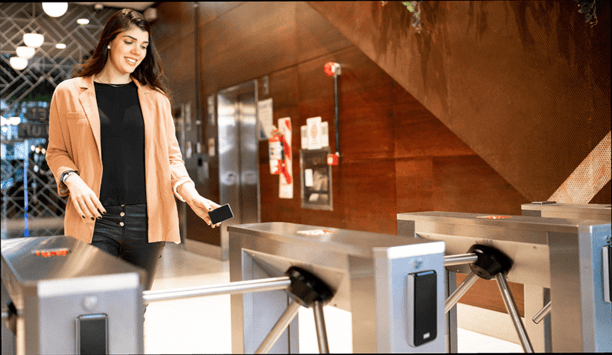
The truth behind 9 mobile access myths
Download
Access control system planning phase 2
Download


